Inbox and Environment News: Issue 461
August 9 - 15, 2020: Issue 461
Time Of Wiritjiribin - Tugarah Gunya'marri (Cold And Windy) August
The lyrebirds' calls ring out through the bushland as he builds his dancing mounds to attract his potential mates. It is the time of the flowering of the Marrai'uo (Acacia floribunda) which is a sign that the fish are running in the rivers. At the end of this time the Boo'kerrikin (Acacia decurrens) flower, which indicates the end of the cold, windy weather, and the beginning of the gentle spring rains.
$250 Million Boost For Public Spaces In NSW
August 5, 2020
Councils across NSW will have the opportunity to deliver new and improved public spaces for their local communities thanks to a $250 million program announced today, as part of the NSW Government's COVID-19 Recovery Plan.
Treasurer Dominic Perrottet said local councils that focus on fast-tracking development assessments for projects that deliver much-needed jobs and housing will be eligible for up to $5.5 million each in funding for parklands, town squares and main streets.
"As part of the NSW Public Spaces Legacy Program, councils that push forward with assessments of job-creating projects will be incentivised with funding for more, and better, public spaces," Mr Perrottet said.
"This program will unlock construction jobs across the State helping combat the economic shocks of COVID-19 while making communities a better place to live."
Minister for Planning and Public Spaces Rob Stokes said the program would create a lasting community benefit across the state.
"In NSW, we've already fast-tracked the determination of 67 projects since the pandemic began - creating opportunities for 40,000 jobs, 18,000 homes, 400 hectares of open space and $17.7 billion in economic benefit through our Planning System Acceleration Program," Mr Stokes said.
"Now we're helping councils to prioritise local planning projects that will boost jobs and investment in their communities with a $250 million incentive to create new and improved public spaces.
"We want councils to think big and bold and deliver legacy projects – new parks, new walking trails, more walkable and inviting streets and open spaces for their communities."
Mr Stokes added that the program will drive more efficient local development and support the delivery of the Premier's Priorities to increase the amount of green, open and public space.
"It builds on the success of the Planning System Acceleration Program to bring greater benefits to neighbourhoods and streets by providing councils the funds to create new or improved public space, as well as encouraging more efficient planning processes."
This new program is only available to the 68 councils currently participating in the e-planning system.
For more information about the NSW Public Spaces Legacy Program and to see if your council is eligible visit the NSW Public Spaces Legacy Program page.
The World Where You Live: Spotted This Week
Turimetta Beach August 3rd, 2020: Beautiful sunrise walk this morning with a mother and calf resting 50m off Turimetta - spotted by Vanessa B.
Australian Eastern Whipbird heard calling at Governor Phillip Park, (north end) Palm Beach, August 5th, 2020 - seen at this park on same day: the Little wattlebird - at north end of Governor Phillip Park, Palm Beach, August 5th, 2020
The little wattlebird (Anthochaera chrysoptera), also known as the brush wattlebird, is a passerine bird in the honeyeater family Meliphagidae. It is found in coastal and sub-coastal south-eastern Australia.
The little wattlebird was formally described by ornithologist John Latham in 1801 under the binomial name Merops chrysoptera. The species is now placed in the genus Anthochaera that was introduced by Nicholas Aylward Vigors and Thomas Horsfield in 1827. The generic name Anthochaera derives from the Ancient Greek anthos 'flower, bloom' and khairō 'enjoy'; the specific epithet chrysoptera derives from Ancient Greek khrysos 'gold' and pteron 'wing'.
The little wattlebird is a medium to large honeyeater, but the smallest wattlebird. The appearance is similar to the yellow wattlebird and the red wattlebird. The little wattlebird lacks the wattles, which characterise other members of the genus. Juveniles are duller with less streaking and have a browner eye.
Calls include a strident cookay-cok, a raucous fetch the gun, a mellow guttural yekkop, yekkop and many squeaky, musical lilting notes. The alarm call is a kwock or shnairt!.
Distribution and habitat: The little wattlebird is found in banksia/eucalypt woodlands, heathlands, tea-tree scrub, sandplain-heaths, lantana thickets, wild tobacco, parks and gardens.
Breeding: Breeding takes place from June to December. The female wattlebird generally constructs the nest, which is a loose, untidy cup of twigs, lined with shredded bark, and placed from 1 to 10 m high in the fork of a banksia, tea-tree or eucalypt sapling. 1-2 eggs are laid and may be spotted red-brown, purplish-red or salmon-pink in colour. The female incubates the eggs alone but both parents care for the young chicks.
Feeding: Little wattlebirds feed on nectar obtained with a long, brush-tipped tongue, adapted for probing deep into flowers. They also feed on insects, berries, and some seeds. Most feeding is done perched, but some insects are caught in mid-air. Birds may feed alone or in groups.
NB: All native birds, reptiles, amphibians and mammals are protected in New South Wales by the Biodiversity Conservation Act 2016 (BC Act).
Uncredited photos by A J Guesdon.
The Australian is a medium-sized black and white passerine bird native to Australia and southern New Guinea. Although once considered to be three separate species, it is now considered to be one, with nine recognised subspecies.
Same headland from a different angle - photo by Mark Pottie, posted on Facebook August 2nd, 2020:
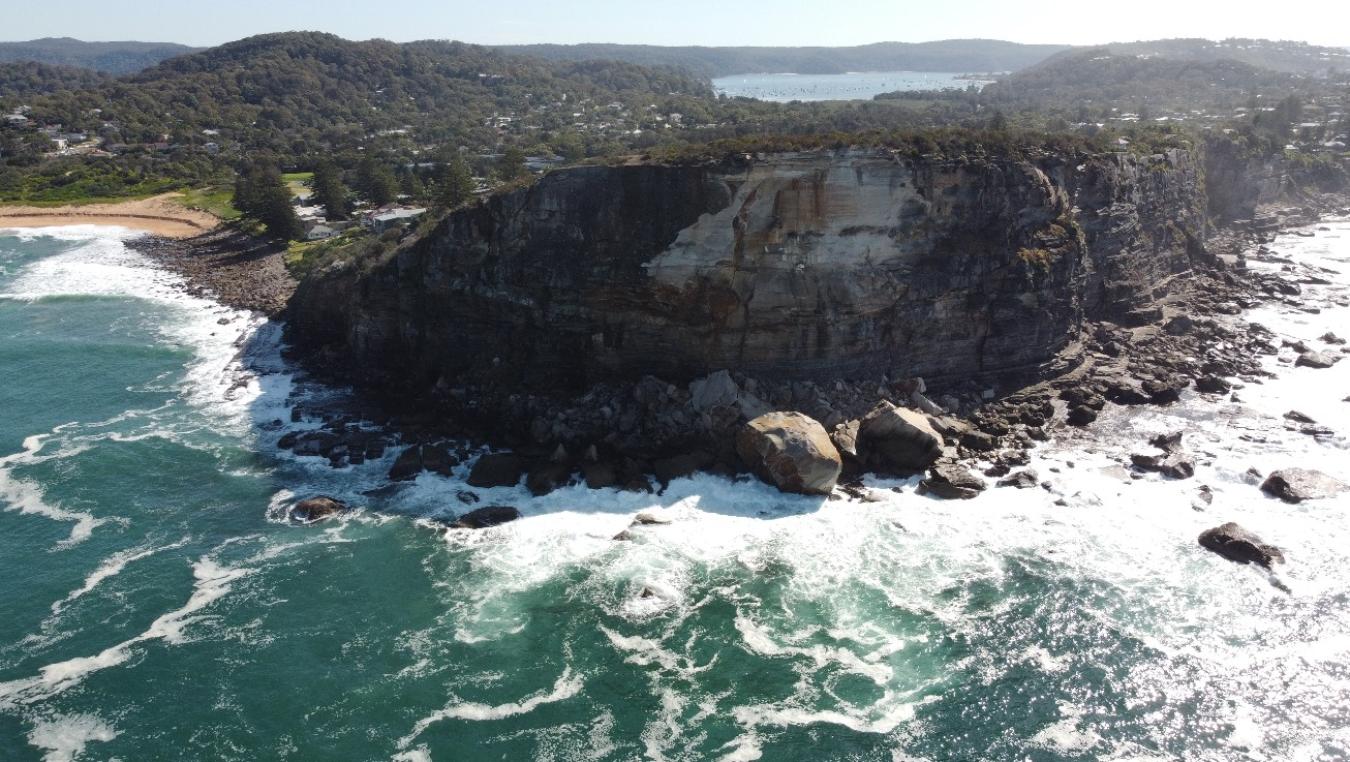
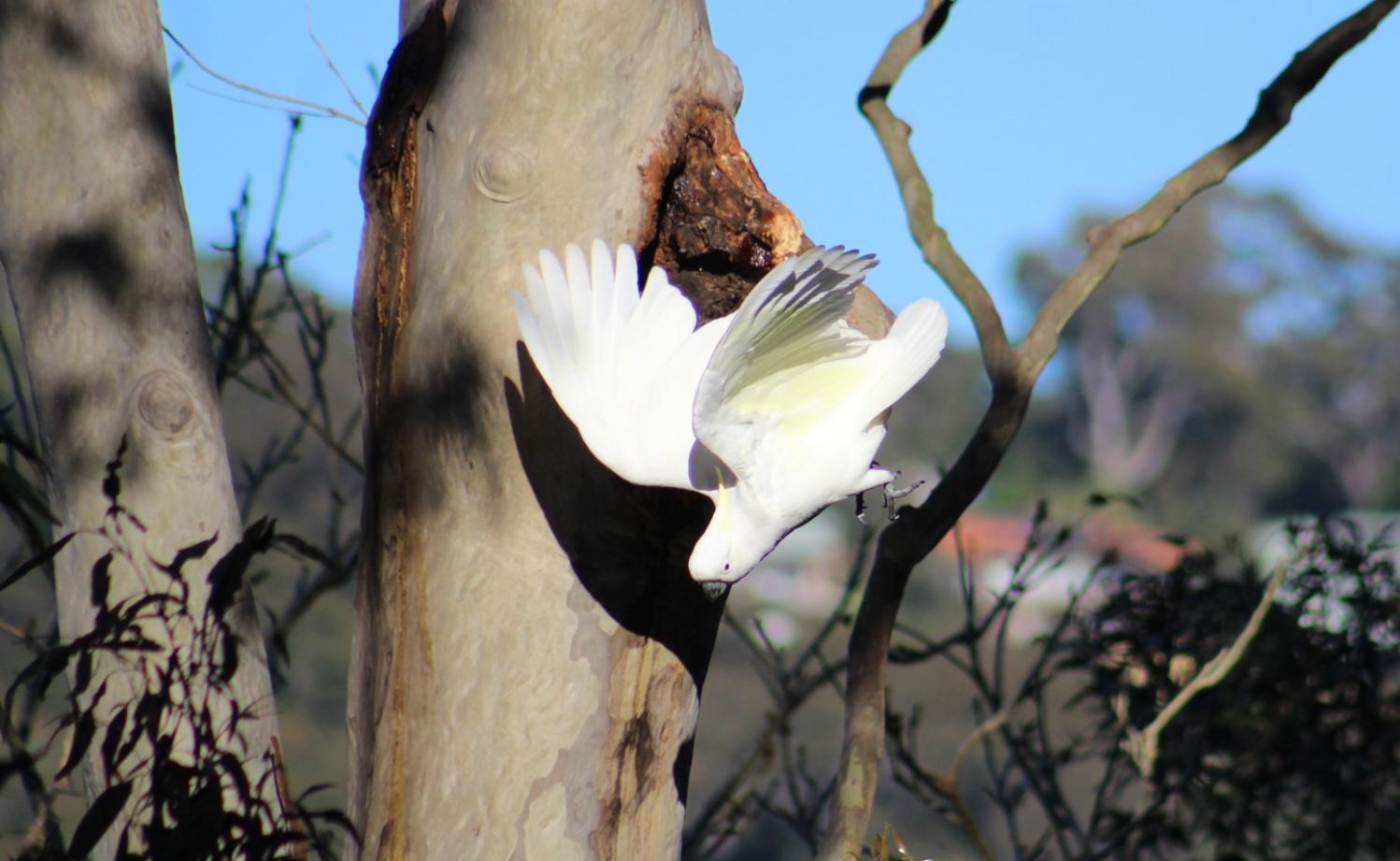
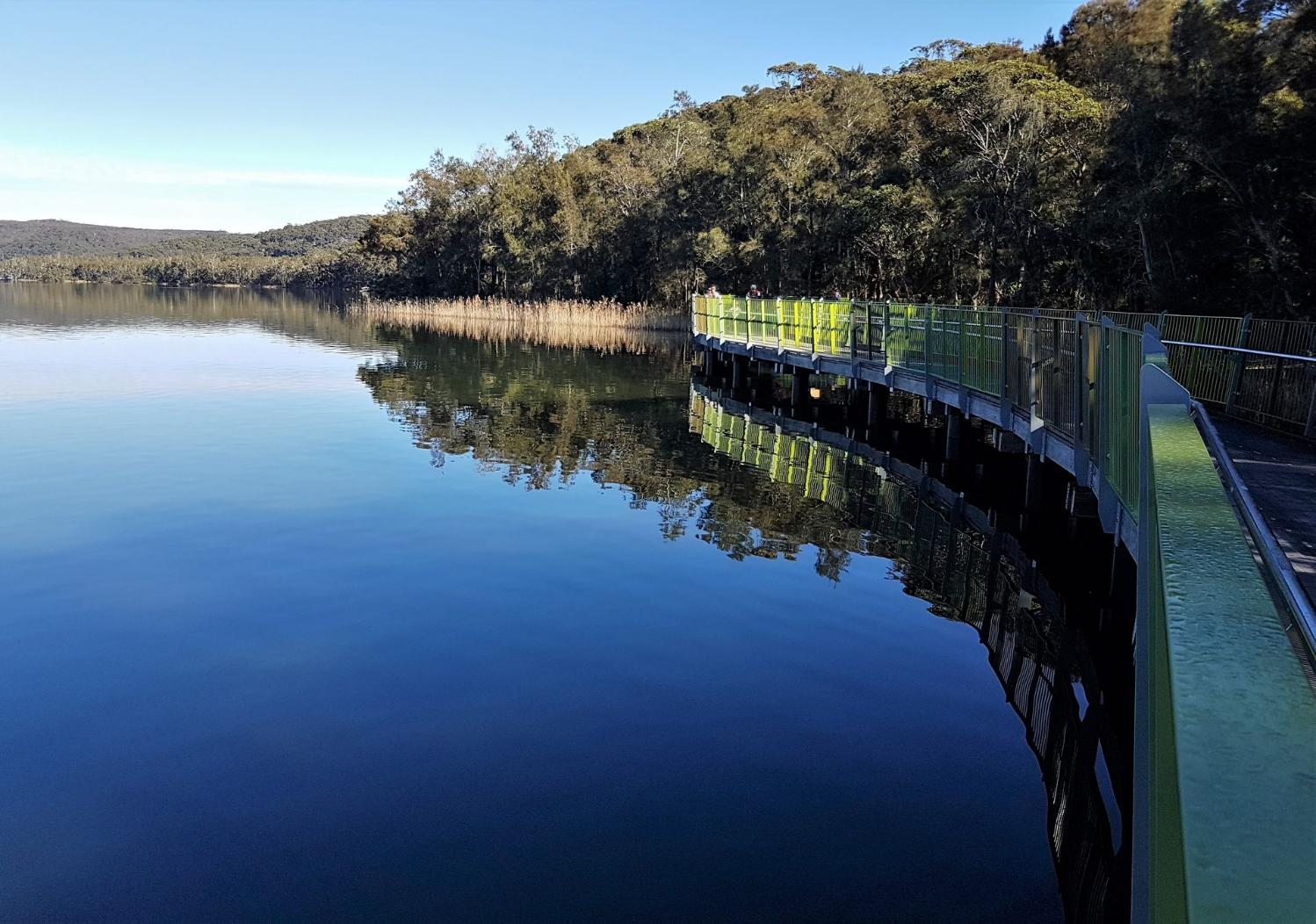

Please Help Sydney Wildlife Rescue: Donate Your Cans And Bottles And Nominate SW As Recipient
You can Help Sydney Wildlife help Wildlife. Sydney Wildlife Rescue is now listed as a charity partner on the return and earn machines in these locations:
- Pittwater RSL Mona Vale
- Northern Beaches Indoor Sports Centre NBISC Warriewood
- Woolworths Balgowlah
- Belrose Super centre
- Coles Manly Vale
- Westfield Warringah Mall
- Strathfield Council Carpark
- Paddy's Markets Flemington Homebush West
- Woolworths Homebush West
- Bondi Campbell pde behind Beach Pavilion
- Westfield Bondi Junction car park level 2 eastern end Woolworths side under ramp
- UNSW Kensington
- Enviro Pak McEvoy street Alexandria.
Every bottle, can, or eligible container that is returned could be 10c donated to Sydney Wildlife.
Every item returned will make a difference by removing these items from landfill and raising funds for our 100% volunteer wildlife carers. All funds raised go to support wildlife.
It is easy to DONATE, just feed the items into the machine select DONATE and choose Sydney Wildlife Rescue. The SW initiative runs until August 23rd.
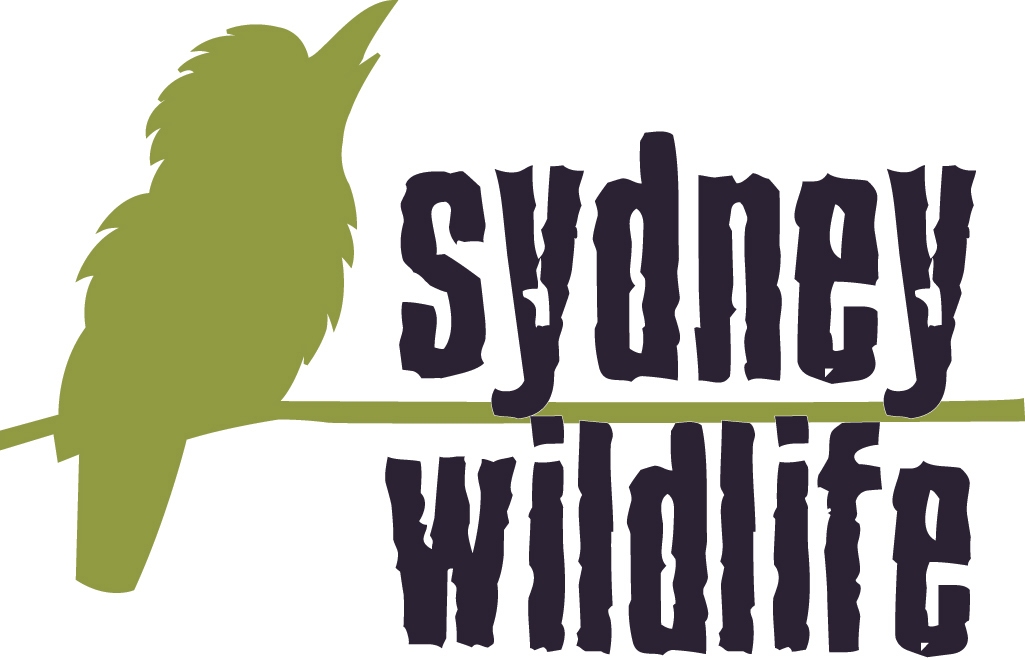
Bushcare In Pittwater
Where we work Which day What time
Avalon
Angophora Reserve 3rd Sunday 8:30 - 11:30am
Avalon Dunes 1st Sunday 8:30 - 11:30am
Avalon Golf Course 2nd Wednesday 3 - 5:30pm
Careel Creek 4th Saturday 8:30 - 11:30am
Toongari Reserve 3rd Saturday 9 - 12noon (8 - 11am in summer)
Bangalley Headland 2nd Sunday 9 to 12noon
Bayview
Winnererremy Bay 4th Sunday 9 to 12noon
Bilgola
North Bilgola Beach 3rd Monday 9 - 12noon
Algona Reserve 1st Saturday 9 - 12noon
Plateau Park 1st Friday 8:30 - 11:30am
Church Point
Browns Bay Reserve 1st Tuesday 9 - 12noon
McCarrs Creek Reserve Contact Bushcare Officer To be confirmed
Clareville
Old Wharf Reserve 3rd Saturday 8 - 11am
Elanora
Kundibah Reserve 4th Sunday 8:30 - 11:30am
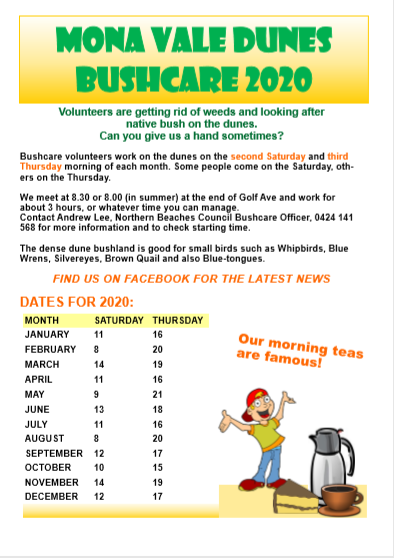 Mona Vale
Mona Vale Mona Vale Beach Basin 1st Saturday 8 - 11am
Mona Vale Dunes 2nd Saturday +3rd Thursday 8:30 - 11:30am
Newport
Bungan Beach 4th Sunday 9 - 12noon
Crescent Reserve 3rd Sunday 9 - 12noon
North Newport Beach 4th Saturday 8:30 - 11:30am
Porter Reserve 2nd Saturday 8 - 11am
North Narrabeen
Irrawong Reserve 2nd Saturday 2 - 5pm
Palm Beach
North Palm Beach Dunes 3rd Saturday 9 - 12noon
Scotland Island
Catherine Park 2nd Sunday 10 - 12:30pm
Elizabeth Park 1st Saturday 9 - 12noon
Pathilda Reserve 3rd Saturday 9 - 12noon
Warriewood
Warriewood Wetlands 1st Sunday 8:30 - 11:30am
Whale Beach
Norma Park 1st Friday 9 - 12noon
Western Foreshores
Coopers Point, Elvina Bay 2nd Sunday 10 - 1pm
Rocky Point, Elvina Bay 1st Monday 9 - 12noon
Gardens And Environment Groups And Organisations In Pittwater
Tick Population Booming In Our Area
Residents from Terrey Hills and Belrose to Narrabeen and Palm Beach report a high number of ticks are still present in the landscape. Local Veterinarians are stating there has not been the usual break from ticks so far and each day they’re still getting cases, especially in treating family dogs.
To help protect yourself and your family, you should:
- Use a chemical repellent with DEET, permethrin or picaridin.
- Wear light-colored protective clothing.
- Tuck pant legs into socks.
- Avoid tick-infested areas.
- Check yourself, your children, and your pets daily for ticks and carefully remove any ticks using a freezing agent.
- If you have a reaction, contact your GP for advice.
First NSW Agriculture Commissioner Appointed
August 3, 2020
Agriculture industry powerhouse Daryl Quinlivan has been appointed the State’s first Agriculture Commissioner, delivering on a major NSW Government election commitment.
Minister for Agriculture Adam Marshall announced Mr Quinlivan’s appointment in Coffs Harbour today and said the Commissioner would champion NSW farmers’ rights.
“Establishing an Agriculture Commissioner was a major NSW Government election commitment and today’s announcement is an important step in delivering the protections and policies our farmers need to grow and thrive,” Mr Marshall said.
“Daryl is incredibly well regarded in industry, having served as the Secretary of the Commonwealth Agriculture Department and headed up the Productivity Commission.
“His wealth of experience will be critical in driving growth in our state’s $16 billion primary industries sector.”
The Agriculture Commissioner will review the NSW Government’s Right to Farm Policy and will have a particular focus on resolving land use conflict and identifying growth opportunities for industry.
“This Government has already introduced the toughest penalties in the nation for farm trespass and now we’re focused on removing other impediments constraining primary production in NSW,” Mr Marshall said.
Member for Coffs Harbour Gurmesh Singh welcomed the announcement and said the Commissioner would be a strong voice for local farmers.
“Coffs Harbour is home to diverse agricultural operations and I look forward to working with the Commissioner to back our farmers and ensure we have a vibrant industry into the future,” Mr Singh said.
Mr Quinlivan said he was honoured to be appointed to the role and would advocate strongly on behalf of the state’s farmers.
“My goal is to a see a stronger and more vibrant agricultural industry in NSW and I look forward to working closely with farmers to understand what they need to take the industry to the next level,” Mr Quinlivan said.
About Daryl Quinlivan
Daryl Quinlivan has held a number of senior roles in the Australian Public Service, working closely on agriculture and food trade related issues. Daryl recently served as Secretary of the Commonwealth Department of Agriculture and Water Resources from 2015-2020. He previously served as Head of Office for the Commonwealth Productivity Commission from 2013-2015 and held a number of other roles including Deputy Secretary at the Commonwealth Department of Agriculture between 2000 and 2011.
About the NSW Agriculture Commissioner
The Commissioner will advocate on behalf of the state’s primary producers and will work with stakeholders to understand barriers to the future success and viability of agriculture in NSW. The Agriculture Commissioner will also be tasked with investigating how land use conflict with primary producers can be mitigated and better managed.
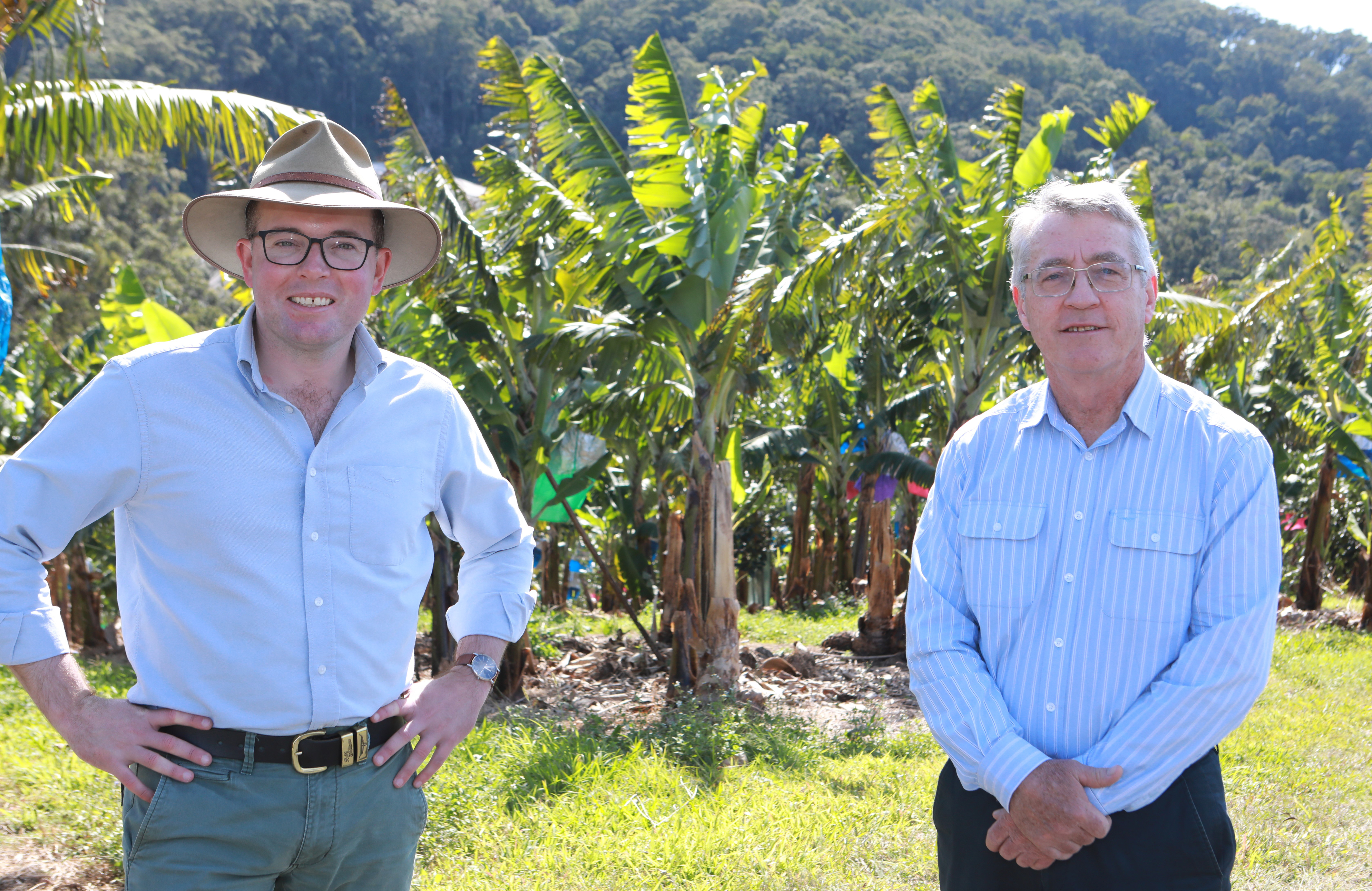
Minister for Agriculture Adam Marshall, left, with the State’s first Agriculture Commissioner Daryl Quinlivan at a Coffs Harbour banana farm. NSW DPI photo
Solitary Ranger Takes To The Water
August 3, 2020
Illegal fishers have nowhere to hide in NSW waters following the launch of the NSW Government’s largest ever offshore patrol vessel.
Minister for Agriculture Adam Marshall officially named and launched ‘Solitary Ranger’ at Coffs Harbour today and said the $3.3 million vessel would be a valuable tool in the NSW Government’s arsenal.
“This is the largest and most technologically advanced vessel we’ve ever had at our disposal, and it will allow us to crack down on illegal fishers from Sydney to the Queensland border and even out to Lord Howe Island,” Mr Marshall said.
“With a greater capacity for long-range patrols, and the ability to handle rough offshore conditions, the Solitary Ranger can head further out to sea where more and more commercial and recreational fishing is taking place.
“Fisheries officers will have the latest mapping and surveillance equipment at their fingertips, such as infrared cameras, to help catch anyone doing the wrong thing.
“It’s critical we maintain a strong compliance presence in NSW waters to ensure we have sufficient fish stocks for generations to come.”
The Solitary Ranger can undertake a range of activities including ocean patrols, surveillance activities and targeted compliance operations.
Member for Coffs Harbour Gurmesh Singh said Coffs Harbour is the perfect location to house the vessel, situated ideally between Sydney and Tweed.
“Our region is home to some of the State’s best fishing spots, so it’s vital we protect our aquatic resources and tackle the issues of illegal fishing head on,” Mr Singh said.
The Solitary Ranger was built by the family-owned North Coast company Yamba Welding and Engineering and at 20 metres long is the largest vessel it has ever built.
The Solitary Ranger’s rigid hull inflatable boat has been named after devoted Department of Primary Industries fisheries officer Wayne Currie, who passed away in 2019.
People are encouraged to report all suspected illegal fishing activities by calling Fishers Watch on 1800 043 536 or via www.dpi.nsw.gov.au/fisheries/compliance
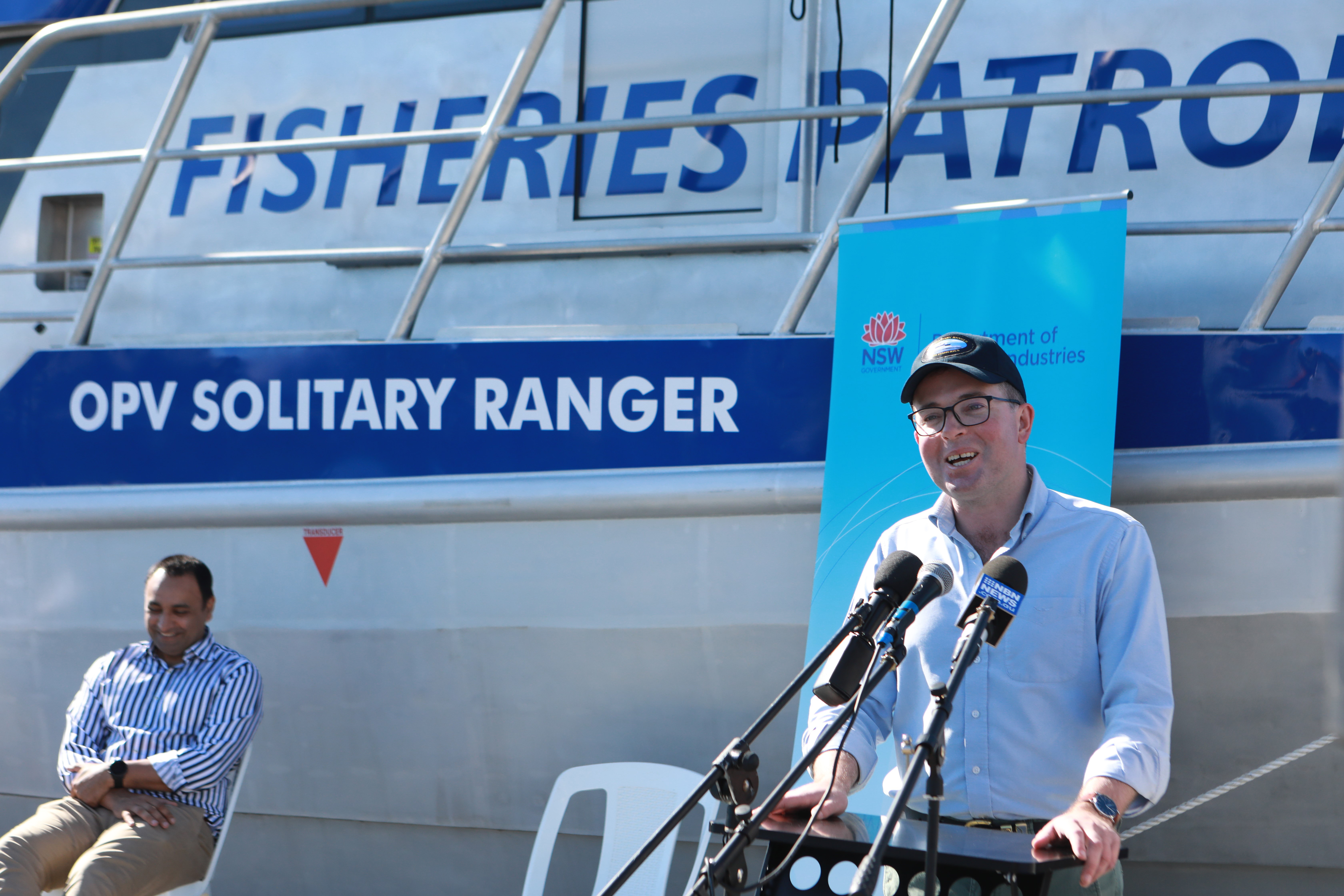
Minister for Agriculture Adam Marshall officially launching the $3.3 million Solitary Ranger in Coffs Harbour. NSW DPI photo
What 'The Birdman of Wahroonga' and other historic birdwatchers can teach us about cherishing wildlife
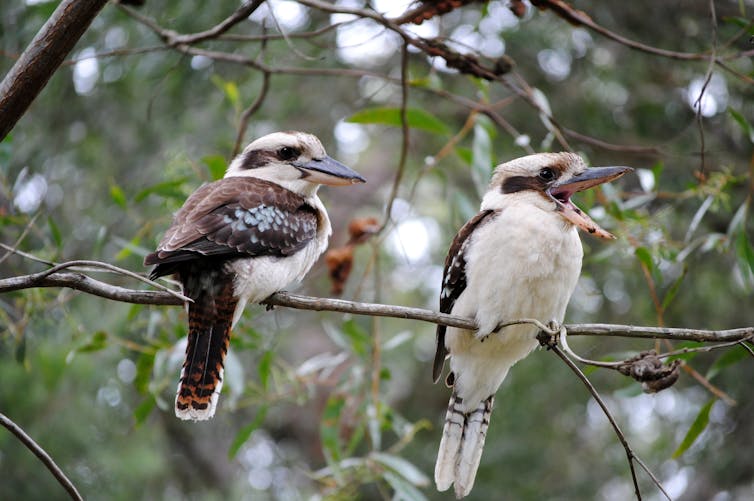
Under the first coronavirus lockdowns, birdwatching increased tenfold in Australia, with much of it done in and near the watchers’ own backyards. And as Melbourne settles into stage 4 restrictions, we’ll likely see this rise again.
The increase in backyard birding is good news for conservation and can help birds recover from bushfires and other environmental catastrophes. But backyard birding isn’t new, nor is its alliance with conservation.
Read more: Birdwatching increased tenfold last lockdown. Don't stop, it's a huge help for bushfire recovery
Since the turn of the 20th century, when birdwatching as a hobby began in Australia, birders have cherished the birds in their backyards as much as those in outback wilds. Birdwatchers admired wild birds anywhere, for one of their big motivations was — and is — to experience and conserve the wild near home.
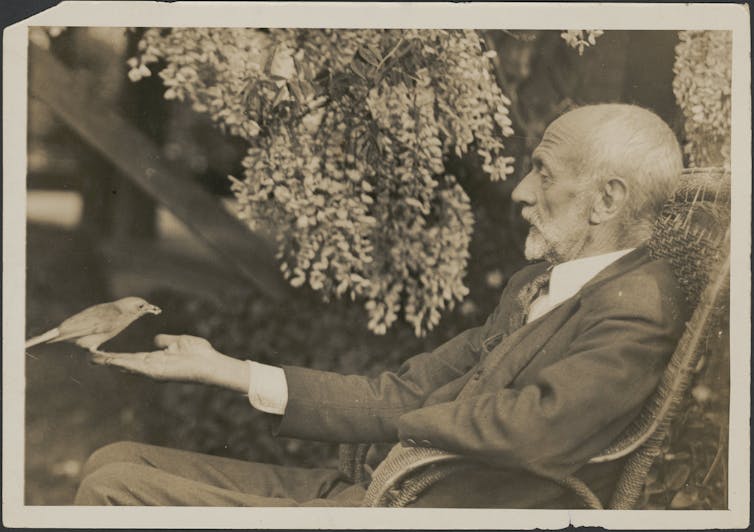
This wasn’t an abstract ambition, but a heartfelt commitment. Birdwatchers have long known that if we are to conserve nature, we need not only the intellectual expertise of science but also an emotional affinity with the living things around us. Birders in Sydney in the 1920s and ‘30s knew this well.
The Birdman Of Wahroonga
Harry Wolstenholme, son of the feminist Maybanke Anderson, was an office-bearer in the Royal Australasian Ornithologists’ Union and a keen amateur birdwatcher. In the 1920s, his usual birding site was his own garden in the northern Sydney suburb of Wahroonga.
There, bird life was prolific. Harry recorded 21 native and five introduced species nesting in or near his garden, plus many more avian visitors.
His garden drew a stream of notable birders from the Sydney branch of the ornithologists’ union, such as wildlife photographer Norman Chaffer, naturalist and journalist Alec Chisholm, and businessman Keith Hindwood. (The union members were predominantly male, though with a liberal sprinkling of women, including Perrine Moncrieff who became its first female president in 1932.)
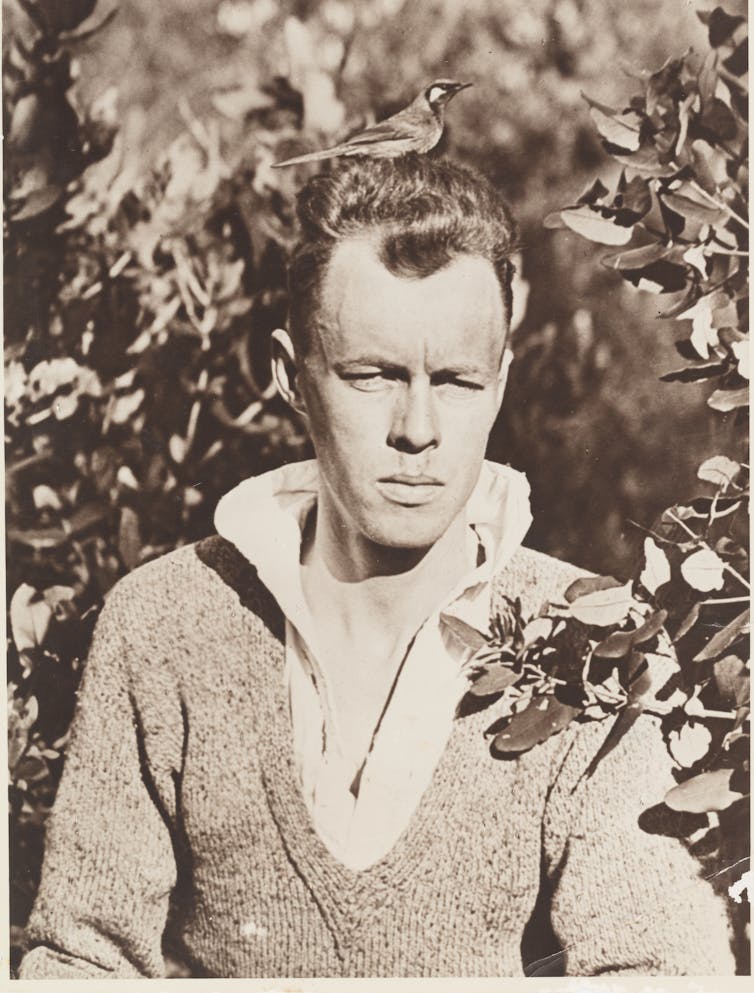
For his closeness to the birds, Harry earned the nickname “The Birdman of Wahroonga”. That suburb still hosts a good range of species, although the bird life is no longer as prolific as in Harry’s day.
Many others birded in city environs and, like Harry, published their suburban ornithological studies in the union journal, The Emu.
In 1932, Alec Chisholm devoted a whole book, Nature Fantasy in Australia, to birding in Sydney and surrounds. Featured on its early pages is a painting by celebrated bird artist Neville Cayley captioned “The Spirit of Sydney: Scarlet Honeyeater at nest in suburban garden”.
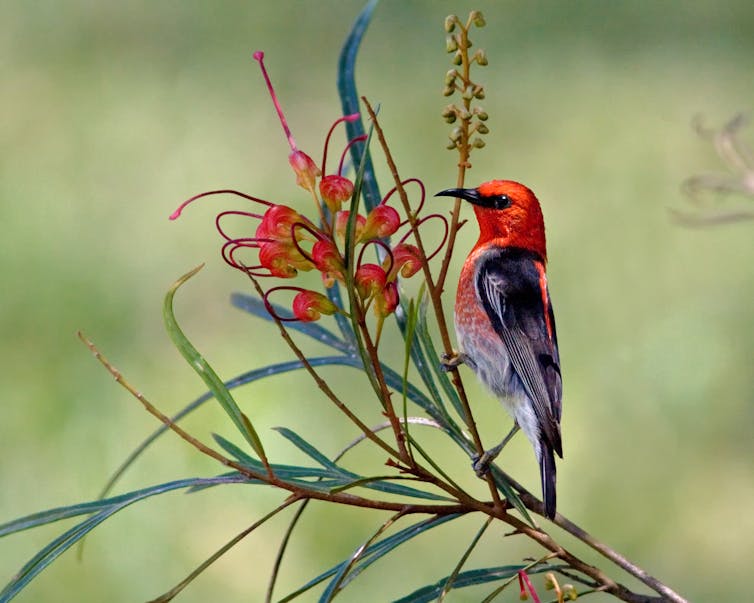
The fact this gorgeous little bird was common in Sydney’s gardens exemplifies Chisholm’s theme of urban Australians’ ready access to the wonders of nature. Scarlet Honeyeaters can still be found in Sydney though they are no longer common there.
Mateship With Birds
Like all Chisholm’s nature writings, Nature Fantasy promoted conservation.
Conservation then differed from conservation now, having a stronger aesthetic orientation and less ecological content. Nonetheless, these pioneer conservationists, among whom birdwatchers were prominent, laid the foundations on which environmentalists later built.
Chisholm urged people not merely to observe birds but also, more importantly, to love and cherish them. In his first book in 1922, Mateship with Birds, he urged readers to open their hearts to their avian compatriots and embrace them as friends and fellow Australians.

One way of fostering this feeling, Chisholm and his birding contemporaries believed, was to give birds attractive names. For example, “Jacky Winter” struck the right note, and as Chisholm wrote:
it would be a healthy thing if we had more of these familiar names for our birds, bringing as they do, a feeling or sense of intimacy.
While those birders urged people to cultivate an emotional connection with nature, and while most were amateur rather than professional ornithologists, they nonetheless made major contributions to the scientific study of birds.
Science was needed, they realised, but so was feeling. As one reviewer of Nature Fantasy enthused, Chisholm was a naturalist “who in his writings combines with the exact research of a scientist the sensibility of a poet”.
Read more: Bath bullies, bacteria and battlegrounds: the secret world of bird baths
Birders Today
Our city birdscapes have since changed. Some species have dwindled; some have increased. But suburbia still holds a remarkable degree of biodiversity, if only we’re prepared to look.
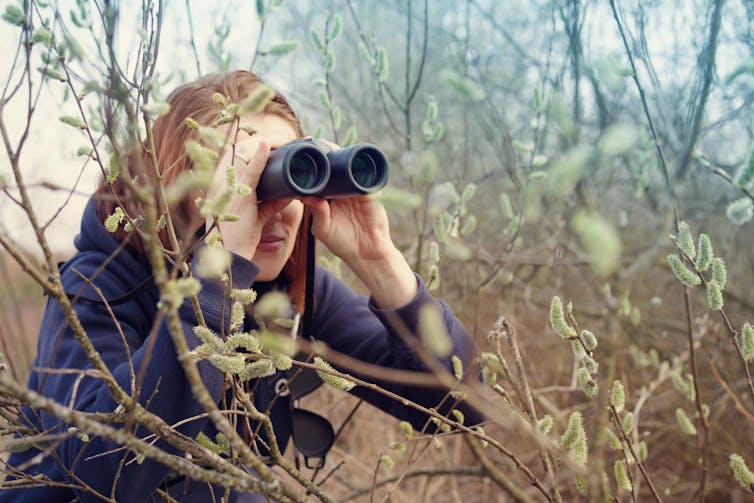
The world of the birders of the 1920s and '30s is gone. Our attitudes toward nature are cluttered with fears unknown in their day, such as climate change. Yet those early birders still have something worthwhile to tell us today: the need to connect emotionally and tangibly with nature.
To hear that message, we need not, and should not, jettison today’s environmental fears. But fear needs complementing with more positive emotions, like love.
Despite — or because of — the prominence of environmental alarms in today’s world, the need to admire and love living things remains as pressing as ever. As birdwatchers have long known, the birds fluttering in our own backyards are adept at fostering those feelings.
Read more: For whom the bell tolls: cats kill more than a million Australian birds every day ![]()
Russell McGregor, Adjunct Professor of History, James Cook University
This article is republished from The Conversation under a Creative Commons license. Read the original article.
Find Out More About Bayview And Palm Beach Visitor Mr. Wolstenholme In:
- Maybanke Selfe-Wolstenholme-Anderson: 2020 International Womens Day + Pittwater Online 10 Years Celebrations
- Pittwater Roads II: Where The Streets Have Your Name - Palm Beach
- Short-Tailed Shearwater Spring Migration Lands In Pittwater - 2013
- Ella McFadyen's Love Of Pittwater: An Environment, Wildlife and Children's Champion
'It is not easy': how science and courage saved the stunning Australian Alps
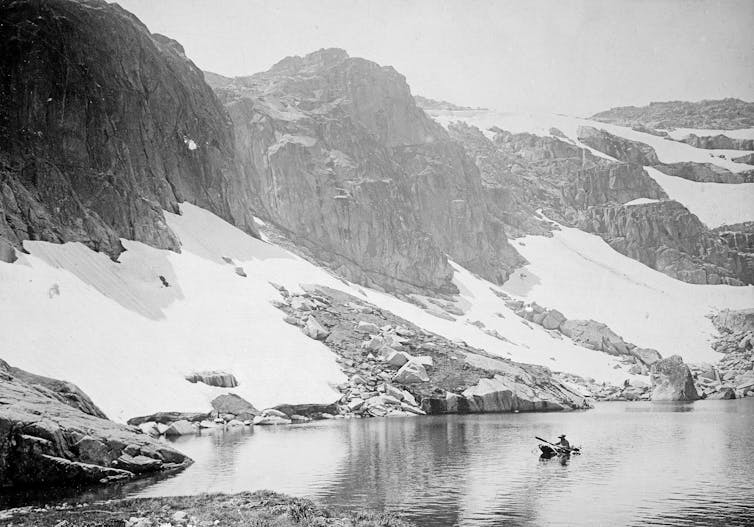
Most people probably associate the Australian Alps with skiing and snow. Others might think of the Man from Snowy River legend or the engineering feats of the Snowy Hydro-Electric Scheme.
But few people know the region’s history of exploitation and overuse, nor the courage of those who fought to save this precious wilderness area. A new book, Kosciuszko: A Great National Park, tells that important story. The result, by authors Deirdre Slattery and Graeme L. Worboys, is a positive yet cautionary tale.
Today, the park is largely protected – yet threats such as ski tourism, feral horses and the Snowy 2.0 scheme still loom. And climate change has left the region highly vulnerable, as shown by declining snow depths and a massive bushfire that tore through the Snowy Mountains last summer.
The book shows how Kosciuszko National Park is the product of robust science and hard-fought battles by dedicated individuals – battles that continue to this day.
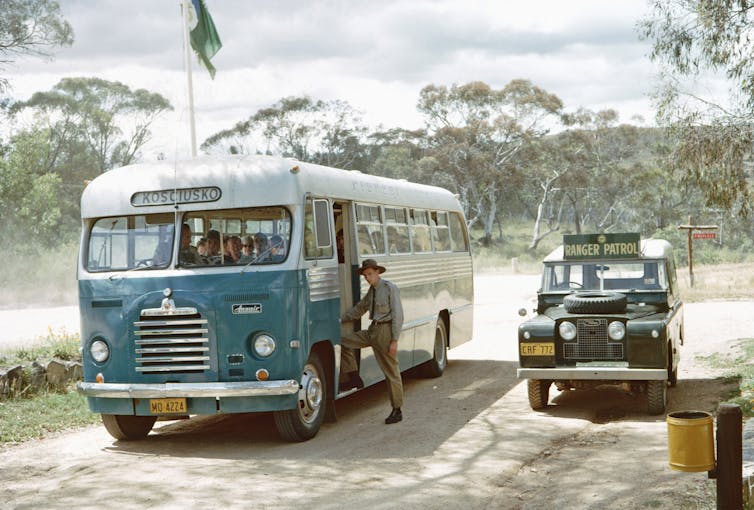
A Long History Of Occupation
The Australian Alps in southeast New South Wales is the traditional home of three Aboriginal groups: the Ngarigo, Walgalu and Djilamatang people. It is home to Australia’s highest peak, Mount Kosciuszko.
The book describes how squatters with cattle occupied the region from the 1820s. By 1840, the Snowy region had been stocked with 200,000 sheep, 75,000 cattle and 3,000 horses which grazed in the mountains each summer.
Read more: We need our Alps, so why aren't we looking after them?
The discovery of gold in 1860 brought another 10,000 people to the Snowy Mountains. By the turn of the 20th century, the mountains were also a playground for recreation. Hotel Kosciusko, with 93 bedrooms, a ballroom, museum, skating rink and tennis courts, catered for an upmarket clientele.
In 1949 the mountains became the site for the Snowy Mountains Hydro-Electric Scheme: 16 dams, 80 kilometres of aqueducts and more than 140 kilometres of tunnels.
By then, the signs of overuse were evident. Soils were eroding, streams became silted and unique alpine flora was diminishing.
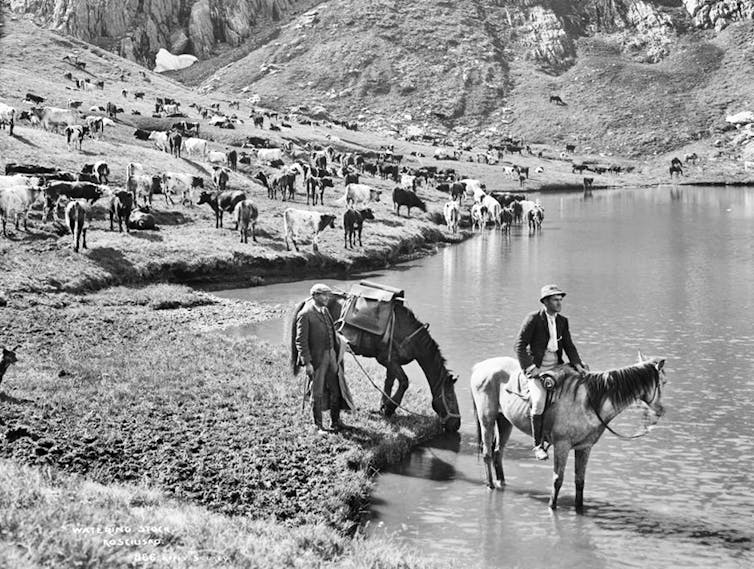
The Long Conservation Fight
Tannat William Edgeworth David, a professor at the University of Sydney, was one of the first to document the unique values of the Snowy Mountains and call for their protection.
In the 1800s, the notion that an ice age once gripped Australia was considered preposterous. The book tells how David and colleagues put the matter “absolutely beyond dispute” when they mapped, on Kosciuszko’s main range, the undeniable signature left by glaciers.
In the early 1900s, David urged that the alpine area be preserved:
[I]t would be wise policy, in the interest of people and of science, to reserve from occupation and even from the depasturing of stock, all the highest points of our alpine plateau, so that this floral wonderland may be preserved intact for posterity…
It took almost 50 years before this advice was heeded. Kosciuszko State Park — later Kosciuszko National Park – was proclaimed in 1944. A decade of further scientific research led to the end of summer grazing leases above 1,350 metres in 1958.
One of the first park managers was Neville Gare. As the book notes, Gare quickly learned that feelings over management of the mountains ran deep. Soon after rangers started impounding stock found illegally in the park, an effigy of a park ranger swinging from a hangman’s noose was installed on the veranda of the Jindabyne Hotel.
Read more: Fire almost wiped out rare species in the Australian Alps. Feral horses are finishing the job
In 1950, Gare resisted a plan by head of the Ski Tourers Association, Charles Anton, to build a network of ski lodges. The book recounts how the tensions culminated at a public function when Anton snipped Gare’s tie in half to “indicate his indifference to Gare’s authority”. Some lodges were later built.
In his unpublished memoir, Gare wrote “it is not easy to conserve something and use it too”. In future years, this observation would prove all too true.
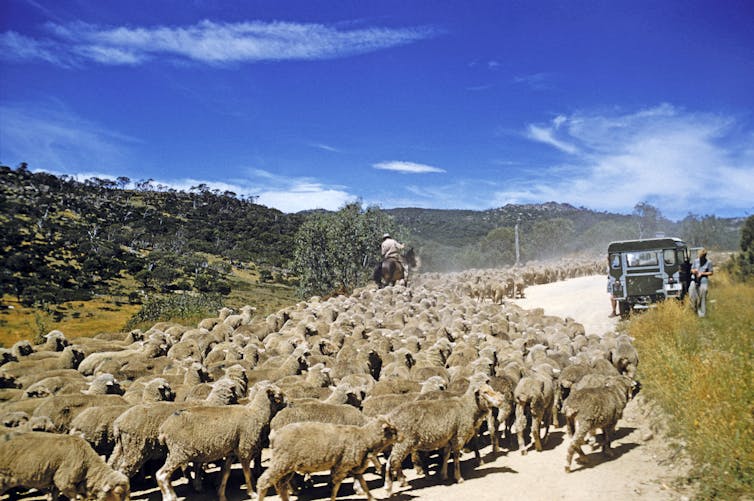
Ongoing Battles
Gare and the Kosciusko State Park Trust developed the first formal plan of management for the park in 1965. The park was divided into zones for different uses: wilderness, conservation of exceptional natural and historic features, development, hydro-electricity and tourism.
This zoning was radical thinking at the time but has since been widely adopted in park management across Australia.
The plan of management for Kosciuszko National Park has been frequently amended to accommodate more tourism facilities, and the threat of further development is ever-present. As the authors note, further pressure is also coming via Snowy 2.0, a A$5 billion proposal to expand the current hydroelectric scheme.
Climate change is also a threat. Rising temperatures have triggered a 15% decline in the annual maximum snow depth, relative to the 1961-90 average.
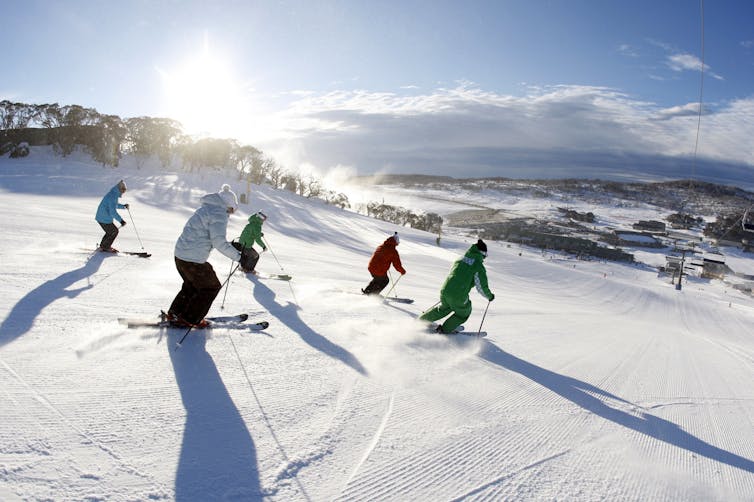
Climate change is also making the threat of bushfires worse. In January, the massive Adaminaby Complex fire burned through more than 93,000 hectares in the Snowy region, affecting swathes of bush. It also devastated populations of several threatened species, including the corroboree frog and the stocky galaxias fish.
And the lethal chytrid fungus, introduced to Australia, has pushed the park’s southern corroboree frog to the brink of extinction.
Read more: NSW has approved Snowy 2.0. Here are six reasons why that's a bad move
In 2018, the NSW government declared feral horses in the park a protected species. The population has quickly grown to about 19,000, representing a considerable threat to several species.
The book reminds us that today, as throughout history, Kosciuszko National Park needs protecting. And key to that are courageous, committed individuals – and robust science.![]()
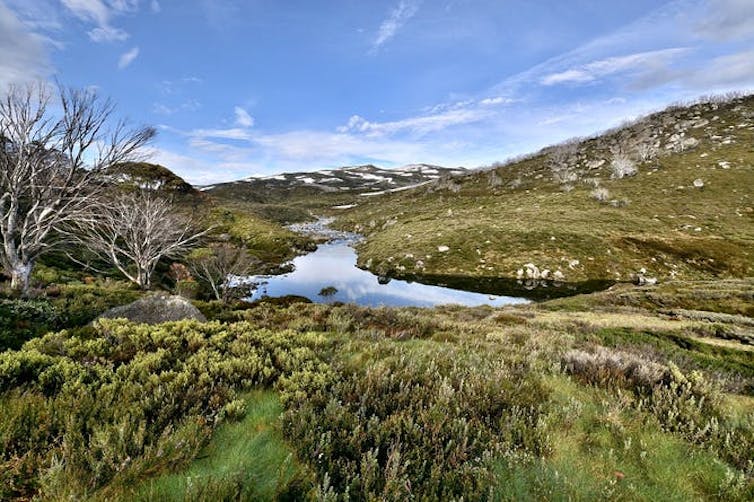
Philip Gibbons, Professor, Australian National University
This article is republished from The Conversation under a Creative Commons license. Read the original article.
Herbivores, Not Predators, Most At Risk Of Extinction
August 5, 2020
One million years ago, the extinction of large-bodied plant-eaters changed the trajectory of life on Earth. The disappearance of these large herbivores reshaped plant life, altered fire regimes across Earth's landscapes, and modified biogeochemical cycling in such a way that Earth's climate became slightly colder. A new study out today by Utah State University Assistant Professor of Watershed Sciences, Trisha Atwood, suggests that modern-day megaherbivores (plant-eaters weighing more than 1000 kg) could soon suffer the same fate as their ancient ancestors, with unknown consequences for Earth and all of its inhabitants.
Armed with a dataset of the diets of over 24,500 mammals, birds, and reptiles, Atwood and her team set out to answer the question "Are plant-eaters, meat-eaters, or animals who eat both plants and meat, at the greatest risk of extinction?" Their findings, published in the journal Science Advances, would challenge a two-decade-long perception that meat-eating predators were the most likely group to meet the ire of Earth's six mass extinction.
The results indicate that with over a quarter of the world's modern-day herbivores threatened with extinction, plant eaters have the highest representation of at-risk species in the present day. The study also highlights that this attack on herbivores is not a new phenomenon. Human activities have led to the disproportionate extinction of herbivores compared to predators since at least the late Pleistocene (11,000-50,000 years ago).
"The results were somewhat shocking," said Atwood. "Our highly publicised and fraught relationship with predatory animals such as lions and wolves has led to the unfounded perception that we are losing predators more than any other trophic group."
Using evidence-based science to challenge misconceptions like the one Atwood's team uncovered is essential for getting society on the right track towards addressing future extinctions. Because a species' role in its ecosystem is intricately linked to what it eats, understanding whether predators, herbivores, or omnivores are at the highest risk of extinction helps scientists and society understand what the potential consequences of losing those species are.
Already the consequences of declines in modern herbivores from land-use change and hunting have begun to echo those that occurred on Earth 1 million years ago; alterations to plant life, changes to fire regimes, and disruptions to nutrient cycling. This study highlights that we must redouble our efforts to strategically invest in conservation and management of herbivores to avoid future dramatic changes in the functions arising from animals at the base of global foodwebs.
Although the results of the study indicate that herbivores are the most at-risk group, it is not clear sailing for predators. The study also identified scavengers, which eat the remains of recently deceased animals (e.g., vultures) and animals that primarily eat fish, such as seabirds, as having a heightened risk of extinction.
"Our results enable us to identify specialized diets within the carnivores that are associated with higher extinction risk, and also identify the habitats these species live in," says Edd Hammill an Assistant Professor of Watershed Sciences at Utah State University and co-author of the study. "It would appear that seabirds across the globe suffer disproportionately high levels of extinction"
To better inform conservation actions, the researchers are now wrestling to understand what it is about herbivores, scavengers, and piscivores (animals that consume fish) that make them more susceptible to extinction compared to other animals.
"Documenting a pattern in extinctions is only the first step towards curbing the loss of species," says Atwood. "Our next step is to understand the intricacies of why this pattern is occurring; only then will we really have a chance at stopping these future extinctions."
Trisha B. Atwood, Shaley A. Valentine, Edd Hammill, Douglas J. McCauley, Elizabeth M. P. Madin, Karen H. Beard, William D. Pearse. Herbivores at the highest risk of extinction among mammals, birds, and reptiles. Science Advances, 2020; 6 (32): eabb8458 DOI: 10.1126/sciadv.abb8458
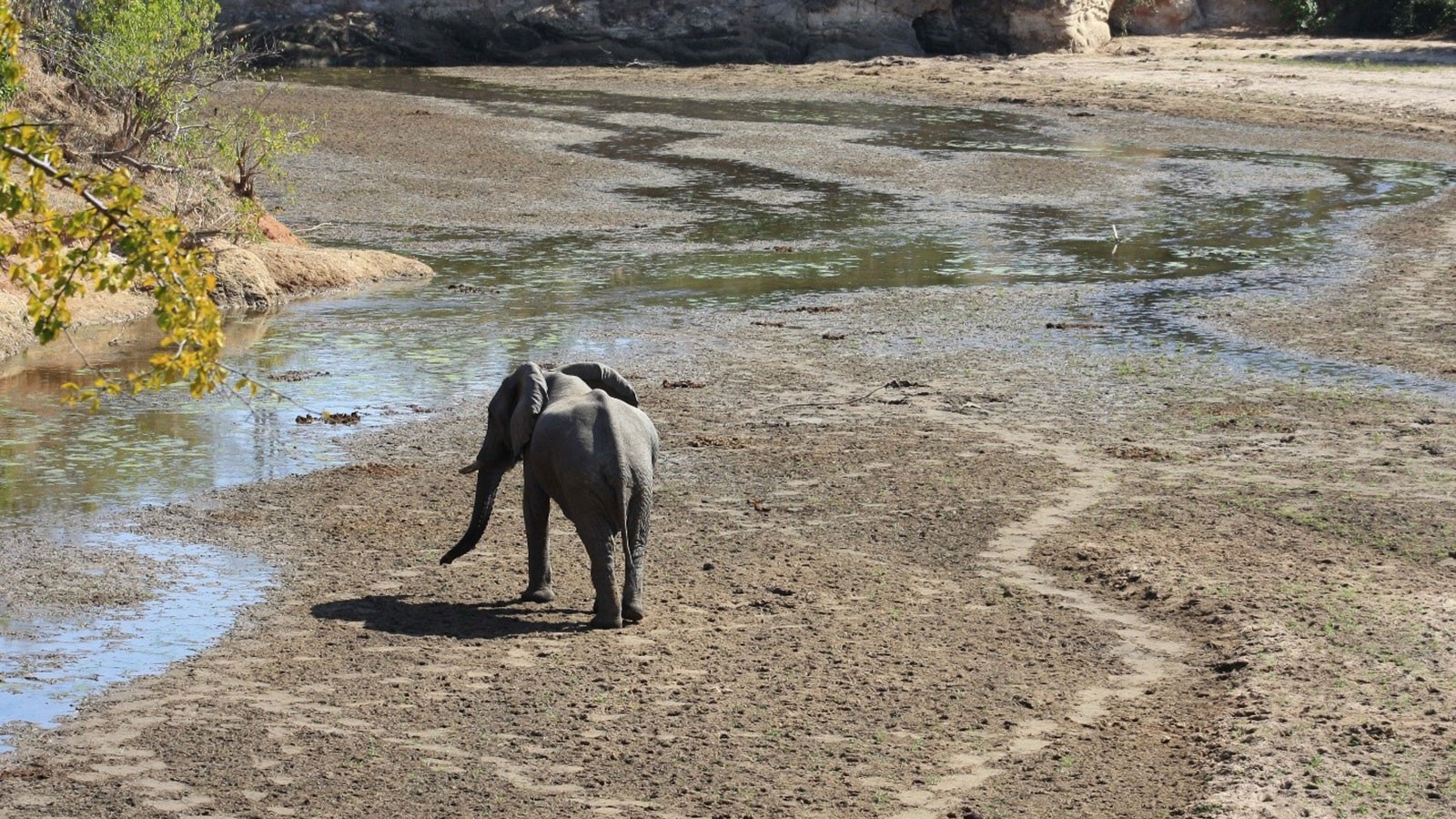
An African Elephant walks through the drying streambed of Chitake Springs as the drought season descends on Mana Pools National Park in Zimbabwe Photo credit: Trisha Atwood.
Whale Airway Mucus Reveals Likely Poor Health During Migration
July 30, 2020: University of New South Wales
Whale-watching season is delighting the viewing public along the east Australian coast but while it's a boon for the tourism industry, for the majestic humpback whale it's potentially a time of less optimal health.
UNSW Sydney researchers collected and analysed samples of whale blow -- similar to mucus from a human nose -- and found "significantly less" microbial diversity and richness on the return leg of the whales' migration, indicating the whales were likely in poorer health than when their journey began.
Microbial diversity accounts for the wide array of microorganisms -- the smallest forms of life.
Lead author Dr Catharina Vendl, UNSW Science researcher, said the study, published in Scientific Reports this week, provided the first evidence whales' airway microbiota was a potential indicator of a whale's overall health.
East Australian humpback whales complete, on average, an arduous 8000-kilometre round trip between Antarctica and Queensland from May to November each year, fasting for most of their journey.
"The physical strains of the humpback's migration likely affected the microbial communities in the whales' airways -- so, our findings are key to further developing the analysis of airway microbiota as a non-invasive method for monitoring the immune function and overall health of whales and dolphins," Dr Vendl said.
"People enjoy whale-watching season, but with it comes reports of whales becoming stranded. Although humpback whale stranding events occur naturally and regularly to injured and young whales, it is crucial to monitor the population health of this iconic species to ensure its long-term survival.
"Humpback whales do not only play an essential role in their marine ecosystem but also represent an important economic resource, because whale watching is a booming industry in many Australian cities and around the world."
Humpback whales were almost hunted to extinction. The last whaling station in NSW, at Byron Bay, closed in 1962 because so few whales could be found.
Humpback whales are now protected throughout Australia, and in NSW are listed as a vulnerable species under the Biodiversity Conservation Act 2016.
Dr Vendl, who has a background in veterinary science, said it was amazing the east and west Australian humpback whale populations had recovered well in the years since whaling stopped.
"So, these whale populations are not endangered, but that doesn't necessarily mean things will stay that way," she said.
Collecting whale 'snot'
Dr Vendl said it was important to find a non-invasive method to study whale health, because many whale populations around the world were endangered -- yet scientists still knew fairly little about whales' physiology.
"Many whale species are at or near the top of their food chain -- so, a whale's general health can be a good indicator of the health of their marine ecosystem," she said.
"Humpback whales mostly live on tiny creatures called krill, but because there is less of this preferred food along the east Australian coast and it's such a huge effort for them to open their mouths to feed, they rely on energy stored in their blubber.
"Fasting is therefore a major physiological strain during the whales' migration."
Dr Vendl collected airway mucus from 20 whales in Hervey Bay, Queensland, during the humpback's return leg to Antarctica when the whales were several months into their migration in August 2017.
The researchers then analysed and compared the whales' blow microbiota to samples Macquarie University scientists collected near Sydney in May and June 2017, for a separate study, when the whales were at the start of their migration.
UNSW Science Professor Tracey Rogers pioneered the technique the UNSW researchers used to examine the whales' airway microbial communities, more than a decade ago.
Dr Vendl said researchers wanted to determine if there was a significant difference between the microbial communities of the whales at the start of and later on in their migration.
"I used two methods to collect the whales' blow while working from a boat. For one method, I flew a waterproof drone over the whales which carried a petri dish," she said.
"It was pure luck waiting for the whales to exhale at the same time the drone was within range for droplets from their blow to settle on the petri dish.
"My second technique was a 4.6-metre long telescopic pole with petri dishes attached to the end. In Hervey Bay, the whales are curious and approach boats.
"So, I held the pole out and waited until the whales exhaled and then collected their samples that way."
Migration pressure link to potential poor health
The study found the whales' respiratory microbiota was severely depleted in diversity and richness the longer they fasted during their migration.
Dr Vendl said such changes often reflected a compromised state of health in the airways of humans.
"We concluded the physical strains of the migration, likely in addition to the exposure to marine pollutants, compromise the whales' immune systems and consequently cause a shift in the whales' airway microbiota.
"Our findings are the first to provide good evidence of a connection between the whales' airway bacterial communities, their physiology and immune function -- something that has been established in humans."
Dr Vendl said a high level of bacterial variety and richness in respiratory microbiota was a sign of healthy airways in humans.
"I researched literature in human medicine: when you have a respiratory disease in a person, it also means the bacterial communities in their airways have changed and are usually depleted," she said.
"We had no idea if we would find a similar pattern in whales, but we at least showed the initial evidence for that occurring."
New potential for non-invasive methods
Dr Vendl said she hoped her research would lead to further study in non-invasive techniques to monitor whale health in populations around the world.
"Our findings showed the first evidence of a link between whales' respiratory microbiota and their overall health, but more research needs to be done," she said.
"Analysing whale blow to assess and monitor whale health opens up more possibilities for the use of non-invasive techniques, such as photogrammetry -- where you fly a drone to film and measure whales to determine how much blubber they have and things like that.
"Other methods were outside the scope of my PhD, but it's important for researchers to experiment with and refine new techniques to assess their effectiveness in helping whale conservation."
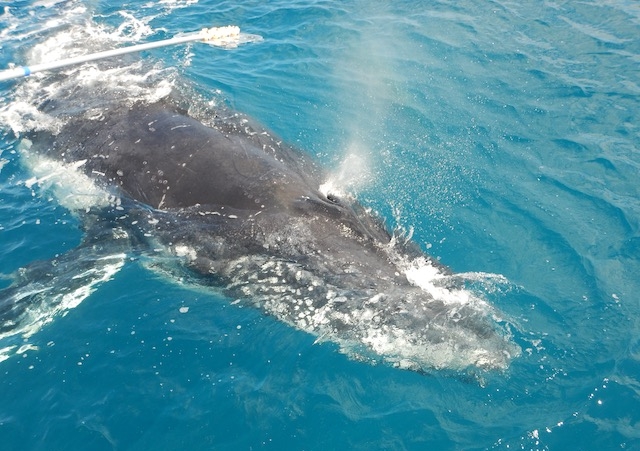
UNSW researchers collect whale snot with a telescopic pole while the whale exhales. Photo: Jordann Crawford-Ash
Catharina Vendl, Eve Slavich, Bernd Wemheuer, Tiffanie Nelson, Belinda Ferrari, Torsten Thomas, Tracey Rogers. Respiratory microbiota of humpback whales may be reduced in diversity and richness the longer they fast. Scientific Reports, 2020; 10 (1) DOI: 10.1038/s41598-020-69602-x
How The Seafloor Of The Antarctic Ocean Is Changing - And The Climate Is Following Suit
August 4, 2020
The glacial history of the Antarctic is currently one of the most important topics in climate research. Why? Because worsening climate change raises a key question: How did the ice masses of the southern continent react to changes between cold and warm phases in the past, and how will they do so in the future? A team of international experts, led by geophysicists from the Alfred Wegener Institute, Helmholtz Centre for Polar and Marine Research (AWI), has now shed new light on nine pivotal intervals in the climate history of the Antarctic, spread over 34 million years, by reconstructing the depth of the Southern Ocean in each one. These new maps offer insights into e.g. the past courses of ocean currents, and show that, in past warm phases, the large ice sheets of East Antarctica reacted to climate change in a similar way to how ice sheets in West Antarctica are doing so today. The maps and the freely available article have just been released in the online journal Geochemistry, Geophysics, Geosystems, a publication of the American Geological Union.
The Southern Ocean is one of the most important pillars of the Earth's climate system. Its Antarctic Circumpolar Current, the most powerful current on the planet, links the Pacific, Atlantic and Indian Oceans, and has effectively isolated the Antarctic continent and its ice masses from the rest of the world for over 30 million years. Then and now, ocean currents can only flow where the water is sufficiently deep and there are no obstacles like land bridges, islands, underwater ridges and plateaus blocking their way. Accordingly, anyone seeking to understand the climate history and glacial history of the Antarctic needs to know exactly what the depth and surface structures of the Southern Ocean's floor looked like in the distant past.
Researchers around the globe can now find this information in new, high-resolution grid maps of the ocean floor and data-modelling approaches prepared by a team of international experts led by geoscientists from the AWI, which cover nine pivotal intervals in the climate history of the Antarctic. "In the course of the Earth's history, the geography of the Southern Ocean has constantly changed, as continental plates collided or drifted apart, ridges and seamounts formed, ice masses shoved deposited sediments across the continental shelves like bulldozers, and meltwater transported sediment from land to sea," says AWI geophysicist and co-author Dr Karsten Gohl. Each process changed the ocean's depth and, in some cases, the currents. The new grid maps clearly show how the surface structure of the ocean floor evolved over 34 million years -- at a resolution of ca. 5 x 5 kilometres per pixel, making them 15 times more precise than previous models.
Dataset reflects the outcomes of 40 years of geoscientific research in the Antarctic
In order to reconstruct the past water depths, the experts gathered geoscientific field data from 40 years of Antarctic research, which they then combined in a computer model of the Southern Ocean's seafloor. The basis consisted of seismic profiles gathered during over 150 geoscientific expeditions and which, when put end-to-end, cover half a million kilometres. In seismic reflection, sound waves are emitted, penetrating the seafloor to a depth of several kilometres. The reflected signal is used to produce an image of the stratified sediment layers below the surface -- a bit like cutting a piece of cake, which reveals the individual layers. The experts then compared the identified layers with sediment cores from the corresponding regions, which allowed them to determine the ages of most layers. In a final step, they used a computer model to 'turn back time' and calculate which sediment deposits were already present in the Southern Ocean at specific intervals, and to what depths in the seafloor they extended in the respective epochs.
Turning points in the climate history of the Antarctic
They applied this approach to nine key intervals in the Antarctic's climate history, including e.g. the warm phase of the early Pliocene, five million years ago, which is widely considered to be a potential template for our future climate. Back then the world was 2 to 3 degrees Celsius warmer on average than today, partly because the carbon dioxide concentration in the atmosphere was as high as 450 ppm (parts per million). The IPCC (IPCC Special Report on the Ocean and Cryosphere in a Changing Climate, 2019) has cited this concentration as the best-case scenario for the year 2100; in June 2019 the level was 415 ppm. Back then, the Antarctic ice shelves now floating on the ocean had most likely completely collapsed. "Based on the sediment deposits we can tell, for example, that in extremely warm epochs like the Pliocene, the large ice sheets in East Antarctica reacted in a very similar way to what we're currently seeing in ice sheets in West Antarctica," reports Dr Katharina Hochmuth, the study's first author and a former AWI geophysicist, who is now conducting research at the University of Leicester, UK.
Accordingly, the new maps provide data on important climatic conditions that researchers around the world need in order to accurately simulate the development of ice masses in their ice-sheet and climate models, and to produce more reliable forecasts. Researchers can also download the corresponding datasets from the AWI's Earth system database PANGAEA.
In addition to researchers from the AWI, experts from the following institutions took part in the study: (1) All Russia Scientific Research Institute for Geology and Mineral Resources of the Ocean, St. Petersburg, Russia; (2) St. Petersburg State University, Russia; (3) University of Tasmania, Australia; (4) GNS Science, Lower Hutt, New Zealand; and (5) the National Institute of Oceanography and Applied Geophysics, Italy.
The grid maps depict the geography of the Southern Ocean in the following key intervals in the climate history and glacial history of the Antarctic:
(1) 34 million years ago -- transition from the Eocene to the early Oligocene; the first continental-size ice sheet on Antarctic continent
(2) 27 million years ago -- the early Oligocene;
(3) 24 million years ago -- transition from the Oligocene to the Miocene;
(4) 21 million years ago -- the early Miocene;
(5) 14 million years ago -- the mid-Miocene, Miocene Climatic Optimum (mean global temperature ca. 4 degrees Celsius warmer than today; high carbon dioxide concentration in the atmosphere);
(6) 10.5 million years ago -- the late Miocene, major continental-scale glaciation;
(7) 5 million years ago -- the early Pliocene (mean global temperature ca. 2 -- 3 degrees Celsius warmer than today; high carbon dioxide concentration in the atmosphere);
(8) 2.65 million years ago -- transition from the Pliocene to the Pleistocene;
(9) 0.65 million years ago -- the Pleistocene.
The data on sediment cores was gathered in geoscientific research projects conducted in connection with the Deep Sea Drilling Project (DSDP), Ocean Drilling Program (ODP), Integrated Ocean Drilling Program, and International Ocean Discovery Program (IODP).
K. Hochmuth, K. Gohl, G. Leitchenkov, I. Sauermilch, J. M. Whittaker, G. Uenzelmann‐Neben, B. Davy, L. De Santis. The Evolving Paleobathymetry of the Circum‐Antarctic Southern Ocean Since 34 Ma: A Key to Understanding Past Cryosphere‐Ocean Developments. Geochemistry, Geophysics, Geosystems, 2020; 21 (8) DOI: 10.1029/2020GC009122
Blue Mountains National Park Plan Of Management Proposed Amendment: Public Consultation
The Proposed Amendment to the Blue Mountains National Park Plan of Management and Govetts Leap Draft Visitor Precinct Plan are available for public review and comment. View Blue Mountains National Park Proposed Amendment to Plan of Management - PDF, 978kb
Public exhibition of the proposed amendment and draft visitor precinct plan provides members of the community with an opportunity to have a say in planned improved accessibility works in Blue Mountains National Park. Comments close 17 August 2020.
What is a plan of management?
Parks and reserves established under the National Parks and Wildlife Act 1974 must have a plan of management. The plan includes information on important park values and provides directions for future management. The plan of management is a legal document, and after the plan is adopted all operations and activities in the park must be in line with the plan. From time to time plans of management are amended to support changes to park management or proposed works.
Why is the plan being amended now?
Blue Mountains National Park is the most visited park in New South Wales, receiving more than 8 million visits in 2018. Visitor infrastructure improvements will enhance and disperse the visitor experience and improve protection of the park's values. The improvements to Govetts Leap visitor precinct will elevate the quality of interpretation and promotion of the park's World Heritage values.
The amendment relates to visitor facility upgrades to support both increased and better-dispersed visitation and includes:
- upgraded and increased capacity parking areas at Govetts Leap
- upgraded facilities to allow improved access for people with disabilities and/or restricted mobility
- enable pre-existing overnight stay facilities at Green Gully visitor precinct including a camping area and cabins.
What opportunities will the community have to comment?
The proposed amendment and draft visitor precinct plan are on public exhibition until Monday 17 August 2020. Everyone is invited to review the amendment and draft visitor precinct plan and provide comments.
When will the amended plan of management and visitor precinct plan be finalised?
At the close of the public exhibition period, we consider all submissions on the plan amendment and prepare a submissions report. We provide the Blue Mountains Regional Advisory Committee and the National Parks and Wildlife Advisory Council with the proposed amendment, all the submissions and the submissions report. They consider the documents, make comments on the amendment or suggest changes, and the Council provides advice to the Minister for Energy and Environment.
The Minister considers the amendment, submissions and advice, makes any necessary changes and decides whether to adopt the amendment under the National Parks and Wildlife Act 1974. Once an amendment is adopted, it is published on the Department's website and key stakeholders, including those who made a submission on the draft plan, will be notified.
Submissions on the draft visitor precinct plan will be reviewed in conjunction with the Blue Mountains Regional Advisory Committee. The finalised Govetts Leap visitor precinct plan will be published on the Department's website.
How can I get more information about the proposed amendment?
For further information on the plan of management please contact the NPWS Park Management Planning Team at npws.parkplanning@environment.nsw.gov.au
Where can I see a printed copy of the proposed amendment?
Copies are available at the following locations:
- National Parks and Wildlife Service Heritage Centre, Blackheath – end of Govetts Leap Road
- Blue Mountains City Council, Katoomba – Ground floor foyer, 2-6 Civic Place
How can I comment on the proposed amendment and draft visitor precinct plan?
Public exhibition of the proposed amendment and draft visitor precinct plan is from Friday 26 June until Monday 17 August 2020. You are invited to comment on the amendment by sending a written submission during this time.
To help us make the best use of your feedback:
- Please tell us what issue or part of the plan you are talking about. One way you can do this is to include the section heading and/or page number from the amendment in your submission.
- Tell us how we can make the plan better. You may want to tell us what you know about the park or how you or other people use and value it.
We are happy to hear any ideas or comments and will consider them all, but please be aware that we can't always include all information or ideas in the final plan.
Your privacy
Your submission will be provided to two advisory bodies. Your comments on the draft plan may include 'personal information'. The Department complies with the NSW Privacy and Personal Information Protection Act 1998, which regulates the collection, storage, quality, use and disclosure of personal information. For details see our privacy page. Information that in some way identifies you may be gathered when you use our website or send us an email.
If you indicate in your written submission that you object to your submission being made public, we will ask you before releasing your submission in response to any access applications under the Government Information (Public Access) Act 2009.
Have your say
Public exhibition is from 26 June 2020 to 17 August 2020.
You can provide your written submission in any of the following ways:
Post your written submission to:
Manager Planning Evaluation and Assessment
Locked Bag 5022
Parramatta NSW 2124
Email your submission to: npws.parkplanning@environment.nsw.gov.au
Make a submission online by using the online form here
Doodle Comer Swamp Nature Reserve Draft Plan Of Management: Public Consultation
The Doodle Comer Swamp Nature Reserve Draft Plan of Management is available for review and comment.
Public exhibition of the draft plan provides an important opportunity for members of the community to have a say in the future management of Doodle Comer Swamp Nature Reserve. Comments close 28 September 2020.
This plan has been prepared using a new format and presented as 2 separate documents:
- The plan of management which is the 'legal' document that will be provided to the Minister for formal adoption. This is the document we are seeking your feedback on.
- The planning considerations document supports the plan of management. It includes detailed information on park values (e.g. threatened species and cultural heritage) and threats to these values. A summary of this information is in the plan of management.
Doodle Comer Swamp Nature Reserve encompasses about half of the Doodle Comer Swamp, an ephemeral wetland listed in the National Directory of Important Wetlands and the largest wetland of its type in southern NSW. The catchment for Doodle Comer Swamp is unregulated and the wetland has an unaltered water flow regime, now uncommon in New South Wales inland wetlands and of high conservation value.
When inundated, Doodle Comer Swamp attracts large numbers of waterbirds that use the swamp for breeding and foraging. When dry, the wetland provides habitat for the threatened bush stone-curlew, listed as endangered in New South Wales. Other threatened animals found include brolga and superb parrot. The reserve contains several threatened ecological communities such as Inland Grey Box Woodland and Sandhill Pine Woodland.
Doodle Comer Swamp is part of the Country of the Wiradjuri speaking nation and is part of a larger network of swamps and lagoons across the Riverina that formed a significant part of the cultural landscape, sustaining the Wiradjuri with an extensive range of resources for thousands of years. A diverse range of Aboriginal sites exist in the reserve and surrounding area and in 2016 Doodle Comer was declared an Aboriginal place recognising these values and the wetland's special significance to Aboriginal culture.
What is a plan of management?
Parks and reserves established under the National Parks and Wildlife Act 1974 need to have a plan of management. The plan includes information on important park values and provides directions for future management. The plan of management is a legal document, and after the plan is adopted all operations and activities in the park must be in line with the plan. From time to time plans of management are amended to support changes to park management. Visit: Doodle Comer Swamp Nature Reserve Draft Plan of Management - PDF, 2.3MB
The National Parks and Wildlife Act sets out the matters that need to be considered when preparing a plan of management. These matters are addressed in the supporting Doodle Comer Swamp Nature Reserve Draft Plan of Management: Planning considerations document.
Why is a plan being prepared now?
Since the park`s reservation in 2011, it has been managed according to a statement of management intent. After a park's reservation and before the release of its plan of management, a statement of management intent is prepared outlining the management principles and priorities for the park's management. This statement documents the key values, threats and management directions for the park. It is not a statutory document and a plan of management will still need to be prepared according to the National Parks and Wildlife Act 1974.
Publication of a draft or final plan will replace the statement of management intent for the relevant parks covered.
What opportunities will the community have to comment?
The draft plan of management is on public exhibition until 28 September 2020 and anyone can review the plan of management and provide comments.
When will the plan of management be finalised?
At the end of the public exhibition period in September 2020 we will review all submissions, prepare a submissions report and make any necessary changes to the draft plan of management. The Far West Regional Advisory Committee and the National Parks and Wildlife Advisory Council will then review the plan along with the submissions and report, as required by the National Parks and Wildlife Act.
Once their input has been considered and any further changes made to the plan of management, we provide the plan to the Minister for Energy and Environment. The plan of management is finalised when the Minister formally adopts the plan under the National Parks and Wildlife Act. Once a plan is adopted it is published on the Department website and a public notice is advertised in the NSW Government Gazette.
How can I get more information about the draft plan?
For further information on the plan of management please contact the Park Management Planning Team at npws.parkplanning@environment.nsw.gov.au.
How can I comment on the draft plan?
Public exhibition for the plan of management is from 26 June 2020 until 28 September 2020. You are invited to comment on the draft plan by sending a written submission during this time.
Have your say
Public exhibition is from 26 June 2020 to 28 September 2020.
You can provide your written submission in any of the following ways:
Post your written submission to:
Manager Planning Evaluation and Assessment
Locked Bag 5022
Parramatta NSW 2124
Email your submission to: npws.parkplanning@environment.nsw.gov.au
Make a submission online by using the online form here
Tollingo Nature Reserve And Woggoon Nature Reserve Draft Plan Of Management: Public Consultation
The Tollingo Nature Reserve and Woggoon Nature Reserve Draft Plan of Management is available for review and comment.
Public exhibition of the draft plan provides an important opportunity for members of the community to have a say in the future management of Tollingo Nature Reserve and Woggoon Nature Reserve. Comments close 28 September 2020.
This plan has been prepared using a new format which is presented as two separate documents:
- The plan of management which is the legal document that will be provided to the Minister for formal adoption. This is the document we are seeking your feedback on.
- The planning considerations document supports the plan of management. It includes detailed information on park values (e.g. threatened species and cultural heritage) and threats to these values. A summary of this information is provided in the plan of management.
Tollingo Nature Reserve and Woggoon Nature Reserve are significant as two of the largest remaining mallee remnants in New South Wales. The largely intact old-age mallee vegetation is rare in the Central West, which is mostly used for agriculture. The reserves provide habitat for the endangered malleefowl and other native animals.
Tollingo Nature Reserve is shared Country for the Ngiyampaa and Wiradjuri people, while Woggoon Nature Reserve is within Wiradjuri traditional Country.
What is a plan of management?
Parks and reserves established under the National Parks and Wildlife Act 1974 need to have a plan of management. The plan includes information on important park values and provides directions for future management. The plan of management is a legal document, and after the plan is adopted all operations and activities in the park must be in line with the plan. From time to time plans of management are amended to support changes to park management.
The National Parks and Wildlife Act sets out the matters that need to be considered when preparing a plan of management. These matters are addressed in the supporting Tollingo Nature Reserve and Woggoon Nature Reserve Draft Planning Considerations document. This document may be updated from time to time, for example, to include new information on the values of the park (e.g. new threatened species), new management approaches (e.g. a new pest management technique) or new park programs. Visit Tollingo Nature Reserve and Woggoon Nature Reserve Draft Plan of Management - PDF 2.3MB
Why is a plan being prepared now?
This plan of management will replace the statement of management intent which was approved in 2014. Statements of management intent are non-statutory documents which summarise the key values and management directions for a park.
Since reservation in 1988 and 1974 respectively, Tollingo and Woggoon nature reserves have been managed according to a statement of management intent. After a park's reservation and before the release of its plan of management, a statement of management intent is prepared outlining the management principles and priorities for the park's management. This statement documents the key values, threats and management directions for the park. It is not a statutory document and a plan of management will still need to be prepared according to the National Parks and Wildlife Act 1974. Publication of a draft or final plan will replace the statements of management intent for the relevant parks covered.
What opportunities will the community have to comment?
The draft plan of management and planning considerations are on public exhibition until 28 September 2020 and anyone can provide comments.
When will the plan of management be finalised?
At the end of the public exhibition period in September 2020, National Parks and Wildlife Service (NPWS) will review all submissions, prepare a submissions report and make any necessary changes to the draft plan of management. The West Regional Advisory Committee and the National Parks and Wildlife Advisory Council will then review the plan along with the submissions and report, as required by the National Parks and Wildlife Act.
Once their input has been considered and any further changes made to the plan of management, we provide the plan to the Minister for Energy and Environment. The plan of management is finalised when the Minister adopts the plan under the National Parks and Wildlife Act. Once a plan is adopted it is published on the Department's website.
How can I get more information about the draft plan?
For further information on the plan of management please contact the NPWS Park Management Planning Team at npws.parkplanning@environment.nsw.gov.au
Where can I see a printed copy of the draft plan?
Hard copies are available for viewing at the following locations:
- National Parks and Wildlife Service (NPWS) office, Camp Street, Forbes
- Condobolin Library, 130 Bathurst Street, Condobolin
How can I comment on the draft plan?
Public exhibition for the plan of management is from 26 June until 28 September 2020. You are invited to comment on the draft plan by sending a written submission during this time.
Your privacy
Your submission will be provided to a number of statutory advisory bodies (including the relevant regional advisory committee and the National Parks and Wildlife Advisory Council). Your comments on the draft plan may include 'personal information'. the Department complies with the NSW Privacy and Personal Information Protection Act 1998 which regulates the collection, storage, access, amendment, use and disclosure of personal information. See our privacy webpage for details. Information that in some way identifies you may be gathered when you use our website or send us correspondence.
If an application to access information under the Government Information (Public Access) Act 2009 requests access to your submission, your views about release will be sought if you have indicated that you object to your submission being made public.
While all submissions count, they are most effective when we understand your ideas and the outcomes you want for park management. Some suggestions to help you write your submission are:
- Write clearly and be specific about the issues that are of concern to you.
- Note which part or section of the plan your comments relate to.
- Give reasoning in support of your points – this makes it easier for us to consider your ideas and will help avoid misinterpretation.
- Tell us specifically what you agree/disagree with and why you agree/disagree.
- Suggest solutions or alternatives to managing the issue if you can.
Have your say
Public exhibition is from 26 June 2020 to 28 September 2020.
You can provide your written submission in any of the following ways:
Post your written submission to:
Manager Planning Evaluation and Assessment
Locked Bag 5022
Parramatta NSW 2124
Email your submission to: npws.parkplanning@environment.nsw.gov.au
Make a submission online by using the online form here
Limeburners Creek National Park, Goolawah National Park And Goolawah Regional Park: Public Consultation
Planning for the future –NSW National Parks and Wildlife Service is preparing a new plan of management for Limeburners Creek National Park, Goolawah National Park and Goolawah Regional Park.
These parks are in the traditional Country of the Dunghutti and Birpai Aboriginal Peoples. The parks play a fundamental role in the lives of local Aboriginal people, helping to maintain a tangible link to the past and enabling continued connections to Country.
The existing plan of management for Limeburners Creek National Park was written in 1998. The areas that are now Goolawah National Park and Goolawah Regional Park were formerly Goolawah State Park and Crown land. Initial community consultation about the Goolawah parks was undertaken in 2012, soon after they were transferred to National Parks and Wildlife Service.
Since this time large new areas have been added to the parks, including the intertidal zone on some of the beaches. There has also been a steady increase in visitors, and new recreational uses have become popular. Information about the values of the park has improved and new approaches to managing fire, pests and weeds have been developed.
Accommodating all of these visitors, maintaining the unique visitor experience and protecting the environment is challenging. Good planning is essential to manage increasing demand and provide sustainable visitor facilities and opportunities while minimising impacts and retaining the natural and low key nature of this beautiful stretch of coast. The development of a new combined plan of management will help to protect the parks' unique values and improve the effectiveness of how we manage the parks.
What opportunities will the community have to contribute to the development of a new plan of management?
Previous consultation, including a community forum, identified a range of issues important to the local community which will be considered in the new plan. It is now time to reach out and reconnect with our neighbours, stakeholders and local communities, as well as extending the invitation to the wider community of park users.
There are now 2 opportunities to be involved in the development of the plan of management for Goolawah Regional Park and Goolawah and Limeburners Creek national parks:
- During the development of the draft plan - register your interest below to receive updates and be notified of further consultation dates. Complete the form to provide your ideas on what you believe are the most important values of the parks and how they should be managed in the future. Your input will be used to draft a plan that reflects community values and aspirations.
- During public exhibition of the draft plan - there will be another opportunity to have your say when the draft plan of management is completed and put on public exhibition for 90 days. Anyone can submit comments on the draft plan during this time.
Register your interest
Complete the online form here to register your interest, provide initial input and be notified of further consultation dates. Tell us what is important to you about the parks and what you would like to see in the future. Comments close 30 October 2020.
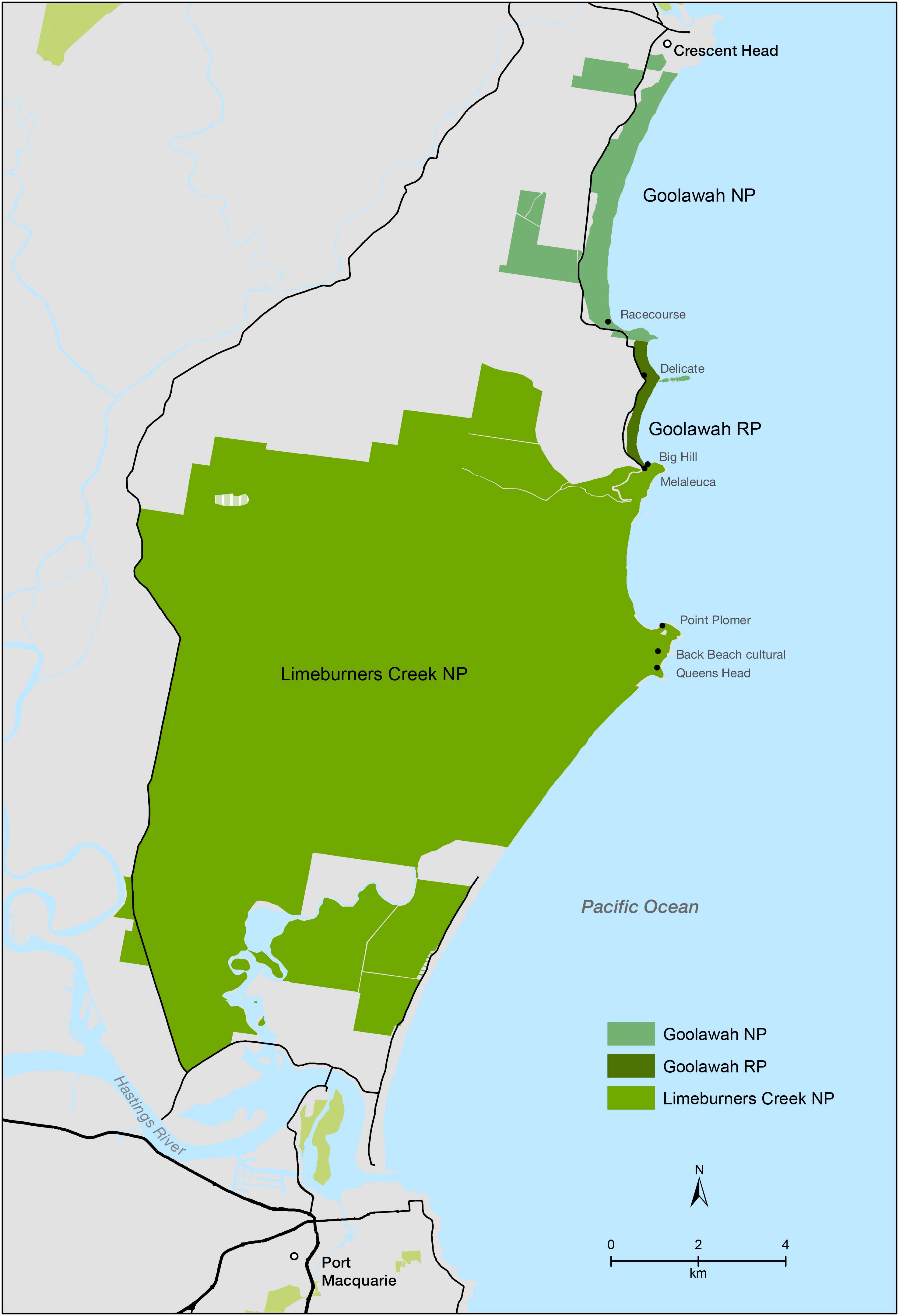
Limeburners Creek National Park, Goolawah National Park and Goolawah Regional Park engagement map Photo: DPIE
Rat Poisons Are Killing Our Wildlife: Alternatives
BirdLife Australia is currently running a campaign highlighting the devastation being caused by poison to our wildlife. Rodentcides are an acknowledged but under-researched source of threat to many Aussie birds. If you missed BirdLife's rodenticide talk but would like to know more, share data and comment on the use of rodenticides in Australia please visit: https://www.actforbirds.org/ratpoison
Owls, kites and other birds of prey are dying from eating rats and mice that have ingested Second Generation rodent poisons. These household products – including Talon, Fast Action RatSak and The Big Cheese Fast Action brand rat and mice bait – have been banned from general public sale in the US, Canada and EU, but are available from supermarkets throughout Australia.
Australia is reviewing the use of these dangerous chemicals right now and you can make a submission to help get them off supermarket shelves and make sure only licenced operators can use them.
There are alternatives for household rodent control – find out more about the impacts of rat poison on our birds of prey and what you can do at the link above and by reading the information below.
Let’s get rat poison out of bird food chains.
The Australian Pesticides and Veterinary Medicines Authority (APVMA) – is currently asking Australians for their views on how rodent poisons are regulated.
Have your say by making a submission here.
Powerful Owl at Clareville - photo by Paul Wheeler
Pesticides that are designed to control pests such as mice and rats cane also kill our wildlife through either primary or secondary poisoning. Insecticides include pesticides (substances used to kill insects), rodenticides (substances used to kill rodents, such as rat poison), molluscicides (substances used to kill molluscs, such as snail baits), and herbicides (substances used to kill weeds).
Primary poisoning occurs when an animal ingests a pesticide directly – for example, a brushtail possum or antechinus eating rat bait. Secondary poisoning occurs when an animal eats another animal that has itself ingested a pesticide – for example, a greater sooty owl eating a rate that has been poisoned or an antechinus that had eaten rat bait.
Rodenticides are the most common and harmful pesticides to Australian wildlife. Though no comprehensive monitoring of non-target exposure of rodenticides has been conducted, numerous studies have documented the harm rodenticides do to native animals. In 2018, an Australian study found that anticoagulant rodenticides in particular are implicated in non-target wildlife poisoning in Australia, and warned Australia’s usage patterns and lax regulations “may increase the risk of non-target poisoning”.
Most rodenticides work by disrupting the normal coagulation (blood clotting) process, and are classified as either “first generation” / “multiple dose” or “second generation” / “single dose”, depending on how many doses are required for the poison to be lethal.
These anticoagulant rodenticides cause victims of anticoagulant rodenticides to suffer greatly before dying, as they work by inhibiting Vitamin K in the body, therefore disrupting the normal coagulation process. This results in poisoned animals suffering from uncontrolled bleeding or haemorrhaging, either spontaneously or from cuts or scratches. In the case of internally haemorrhaging, which is difficult to spot, the only sign of poisoning is that the animal is weak, or (occasionally) bleeding from the nose or mouth. Affected wildlife are also more likely to crash into structures and vehicles, and be killed by predators.
An animal has to eat a first generation rodenticide (e.g. warfarin, pindone, chlorophaninone, diphacinone) more than once in order to obtain a lethal dose. For this reason, second generation rodenticides (e.g. difenacoum, brodifacoum, bromadiolone and difethialone) are the most commonly used rodenticides. Second generation rodenticides only require a single dose to be consumed in order to be lethal, yet kill the animal slowly, meaning the animal keeps coming back. This results in the animal consuming many times more poison than a single lethal dose over the multiple days it takes them to die, during which time they are easy but lethal prey to predators. This is why second generation poisons tend to be much more acutely toxic to non-target wildlife, as they are much more likely to bioaccumulate and biomagnify, and clear very slowly from the body.
Species most at risk from poisons
Small Mammals
Small mammals including possums and bandicoots often consume poisons such as snail bait, or rat bait that has been laid out to attract and kill rats, mice, and rabbits. Poisons such as pindone are often added to oats or carrots, and lead to a slow, painful death of internal bleeding. Australian possums often consume rat bait such as warfarin, which causes extensive internal bleeding, usually resulting in death.
There is a very poor chance of survival. Possums are also known to consume slug bait, which results in a prolonged painful death mainly from neurological effects. There is no treatment.
Small mammals can also be poisoned by insecticides. Possums, for example, can ingest these poisons when consuming fruit from a tree that has been sprayed with insecticide. Rescued by a WIRES carer, the brushtail possum joey pictured below was suffering from suspected insecticide poisoning. Though coughing up blood, luckily the joey did not ingest a lethal dose as he survived in care and was later released.
Large Mammals
Despite their size, large mammals including wallabies, kangaroos and wombats can also fall victim to pesticide poisoning. Wallabies and kangaroos have been known to suffer from rodenticide poisoning, while poisons often ingested by wombats include rat bait from farm sheds, and sodium fluroacetate (1080) laid out to kill pests such as cats and foxes.
Australian mammals are also impacted by the use of insecticides. DDT, although a banned substance, has been reported as killing marsupials.
Birds
Birds have a high metabolic rate and therefore succumb quickly to poisons. Australian birds of prey – owls (such as the southern boobook) and diurnal raptors (such as kestrels) – can be killed by internal bleeding when they eat rodents that have ingested rat bait. A 2018 Western Australian study determined that 73% of southern boobook owls found dead or were found to have anticoagulant rodenticides in their systems, and that raptors with larger home ranges and more mammal-based diets may be at a greater risk of anticoagulant rodenticide exposure.
Insectivorous birds will often eat insects sprayed with insecticides, and a few different species of birds may be affected at the same time. Unfortunately little can be done and death most often results.
Organophosphates are the most widely used insecticide in Australia. Birds are very susceptible to organophosphates, which are nerve toxins that damage the nervous system, with poisoning occurring through the skin, inhalation, and ingestion. Organophosphates can cause secondary poisoning in wild birds which ingest sprayed insects. Often various species of insectivorous birds are affected at the same time as they come down to eat the dying insects. After a bird is poisoned, death usually occurs rapidly. Raptors have also been deliberately or inadvertently poisoned when organophosphates have been applied to a carcass to poison crows.
Organochlorine pesticides (OCPs) are persistent, bio-accumulative pesticides that include DDT, dieldrin, heptachlor and chlordane. OPC’s have been used extensively in the agriculture industry since the 1940s. Some of the more common product names include Hortico Dieldrin Dust, Shell Dieldrex and Yates Garden Dust. Although no OCP’s are currently registered for use in the home environment in Australia, many of these products still remain in use on farms, in business premises and households. OCP poisons remain highly toxic in the environment for many years impacting on humans, animals, birds and especially aquatic life. They can have serious short-term and long-term impacts at low concentrations. In addition, non-lethal effects such as immune system and reproductive damage of some of these pesticides may also be significant. Birds are particularly sensitive to these pesticides, and there have even been occasions where the deliberate poisoning of birds has occurred. Tawny frogmouths are most often poisoned with OCP’s. The poisons are stored in fat deposits and gradually increase over time. At times of food scarcity, or during any stressful period, such as breeding season or any changes to their environment, the fat stores are metabolised, and with it, the poison load in their blood streams reaches acute levels, causing death.
Although herbicides, or weed killers, are designed to kill plants, some are toxic to birds. Common herbicide glyphosate (Roundup) will cause severe eye irritation in birds if they come into contact with the spray. Herbicides also have the impact of removing food plants that birds, or their insect food supply, rely on. Birds can also readily fall victim to snail baits, either via primary or secondary poisoning.
Reptiles and Amphibians
As vertebrate species, reptiles and amphibians are also at risk of pesticides. Though less is known about the effects of pesticides on reptiles and amphibians, these animals have been known to fall victim to pesticide poisoning. Blue-tongue lizards, for example, often consume rat bait and die of internal bleeding. A 2018 Australian study also found that reptiles may be important vectors (transporters) of rodenticides in Australia.
How to keep pests away and keep wildlife safe
Remember, pesticides are formulated to be tasty and alluring to the target species, but other species find them enticing, too. It is safest for wildlife, pets and people for us to not use any pesticides, and prevent or deter the presence of pests practically, rather than attempt to eliminate them chemically.
Tips to prevent and deter wildlife deaths from poisoning:
- Deter rats and mice around your property by simply cleaning up; removing rubbish, keeping animal feed well contained and indoors, picking up fallen fruits and vegetation, and using chicken feeders removes potential food sources.
- Seal up holes and in your walls and roof to reduce the amount of rodent-friendly habitat in your house.
- Replace palms with native trees; palm trees are a favourite hideout for black rats, while native trees provide ideal habitat for native predators like owls and hawks which help to control rodent populations.
- Set traps with care in a safe, covered spot, away from the reach of children, pets and wildlife. Two of the most effective yet safe baits are peanut butter and pumpkin seeds.
- To control slugs, terracotta or ceramic plant pots can be placed upside down in the garden or aviary. Slugs and snails will seek the dark, damp area this creates, and can be collected daily. They can then be drowned in a jar of soapy water. You can also sink a jar or dish into the soil and fill it with beer. The slugs are attracted to the yeast in the beer, fall in and then drown.
If turning to pesticides as a last resort:
- Use only animal-safe slug baits.
- Place tamper-proof bait stations out of reach of wildlife.
- Avoid using loose whether pellets or poison grain, present the highest risk, the latter being particularly attractive to seed-eating birds and to many small mammal species.
- Read the label and use as instructed.
- Avoid products containing second generation products difenacoum, brodifacoum, bromadiolone and difethialone, which are long-lasting and much more likely to unintentionally poison wildlife via secondary poisoning.
- Cover individual fruits when spraying fruit trees with insecticides.
Poisons kill dogs too
Because of their poisonous nature, pesticides pose a risk to animals and people alike, including pets and children. Roaming pets like cats and dogs are most at risk of being poisoned, with one 2016 study at the Norwegian University of Life Sciences finding that one in five dogs had rat poison in its body, and a 2011 study by the Humane Society in the United States finding that 74% of their pet poisoning cases are due to second-generation anticoagulants such as rat baits.
It is best to avoid the use of all pesticides, or otherwise use them sparingly, carefully and only after researching each poison and its correct usage. Always supervise pets and children, keep poisons locked out of their reach, and be vigilant in public spaces where pesticides may have accumulated, e.g. poisons can accumulate in streams or puddles where herbicides have recently been sprayed.
If you suspect your pet has been poisoned, seek veterinary help immediately.
If you suspect your child or another adult has been poisoned, do not induce vomiting and call the NSW Poisons Information Centre on 13 11 26 for 24/7 medical advice, Australia-wide.
References
Lohr, M. T. & Davis, R. A. 2018, Anticoagulant rodenticide use, non-target impacts and regulation: A case study from Australia, Science of The Total Environment, vol. 634, pp. 1372-1384.
Lohr, M. T. 2018, Anticoagulant rodenticide exposure in an Australian predatory bird increases with proximity to developed habitat, Science of The Total Environment, Volume 643, pp.134-144.
Lohr, M. T. 2018, Anticoagulant Rodenticides: Implications for Wildlife Rehabilitation, conference paper, Australian Wildlife Rehabiliation Conference, awrc.org.au
Olerud, S., Pedersen, J. & Kull, E. P. 2009, Prevalence of superwarfarins in dogs – a survey of background levels in liver samples of autopsied dogs. Norwegian University of Life Sciences, Faculty of Veterinary Medicine and Life Sciences, Department of Sports and Family Animal Medicine, Section for Small Animal Diseases.
Healthy Wildlife, Healthy Lives, 2017, Rodenticides and Wildlife, healthywildlife.com.au
Society for the Preservation of Raptors Inc. 2019, Raptor Fact Sheet: Eliminate Rats and Mice, Not Wildlife!, raptor.org.au/factsheetpests.pdf
W.I.R.E.S. Poisons and baits don't just kill rats.
.jpg?timestamp=1590728675788)
Barking Owl (Ninox connivens connivens)- photo by Julie Edgley - this nocturnal animal will eat mice and so become a victim of poisons through them
Echidna Season
Echidna season has begun. As cooler days approach, our beautiful echidnas are more active during the days as they come out to forage for food and find a mate. This sadly results in a HIGH number of vehicle hits.
What to do if you find an Echidna on the road?
- Safely remove the Echidna off the road (providing its safe to do so).
- Call Sydney Wildlife or WIRES
- Search the surrounding area for a puggle (baby echidna). The impact from a vehicle incident can cause a puggle to roll long distances from mum, so please search for these babies, they can look like a pinky-grey clump of clay
What to do if you find an echidna in your yard?
- Leave the Echidna alone, remove the threat (usually a family pet) and let the Echidna move away in it's own time. It will move along when it doesn't feel threatened.
If you find an injured echidna or one in an undesirable location, please call Sydney Wildlife on 9413 4300 for advice.
www.sydneywildlife.org.au
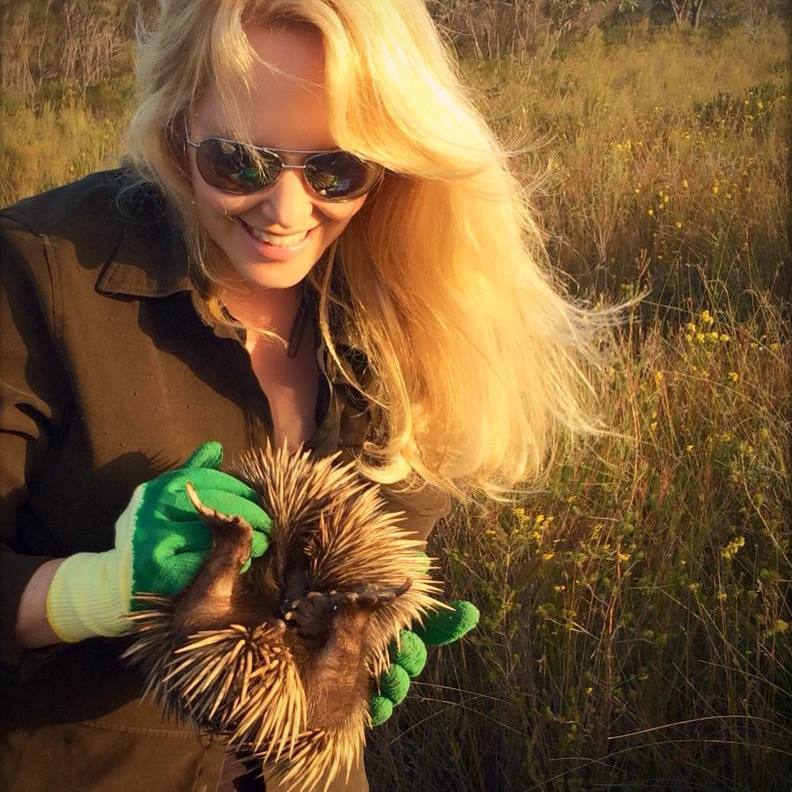
Lynleigh Greig, Sydney Wildlife, with a rescued echidna being returned to its home
 New Shorebird Identification Booklet
New Shorebird Identification Booklet
The Migratory Shorebird Program has just released the third edition of its hugely popular Shorebird Identification Booklet. The team has thoroughly revised and updated this pocket-sized companion for all shorebird counters and interested birders, with lots of useful information on our most common shorebirds, key identification features, sighting distribution maps and short articles on some of BirdLife’s shorebird activities.
The booklet can be downloaded here in PDF file format: http://www.birdlife.org.au/documents/Shorebird_ID_Booklet_V3.pdf
Paper copies can be ordered as well, see http://www.birdlife.org.au/projects/shorebirds-2020/counter-resources for details.
Download BirdLife Australia's children’s education kit to help them learn more about our wading birdlife
Shorebirds are a group of wading birds that can be found feeding on swamps, tidal mudflats, estuaries, beaches and open country. For many people, shorebirds are just those brown birds feeding a long way out on the mud but they are actually a remarkably diverse collection of birds including stilts, sandpipers, snipe, curlews, godwits, plovers and oystercatchers. Each species is superbly adapted to suit its preferred habitat. The Red-necked Stint is as small as a sparrow, with relatively short legs and bill that it pecks food from the surface of the mud with, whereas the Eastern Curlew is over two feet long with a exceptionally long legs and a massively curved beak that it thrusts deep down into the mud to pull out crabs, worms and other creatures hidden below the surface.
Some shorebirds are fairly drab in plumage, especially when they are visiting Australia in their non-breeding season, but when they migrate to their Arctic nesting grounds, they develop a vibrant flush of bright colours to attract a mate. We have 37 types of shorebirds that annually migrate to Australia on some of the most lengthy and arduous journeys in the animal kingdom, but there are also 18 shorebirds that call Australia home all year round.
What all our shorebirds have in common—be they large or small, seasoned traveller or homebody, brightly coloured or in muted tones—is that each species needs adequate safe areas where they can successfully feed and breed.
The National Shorebird Monitoring Program is managed and supported by BirdLife Australia.
This project is supported by Glenelg Hopkins Catchment Management Authority and Hunter Local Land Services through funding from the Australian Government’s National Landcare Program. Funding from Helen Macpherson Smith Trust and Port Phillip Bay Fund is acknowledged.
The National Shorebird Monitoring Program is made possible with the help of over 1,600 volunteers working in coastal and inland habitats all over Australia.
The National Shorebird Monitoring program (started as the Shorebirds 2020 project initiated to re-invigorate monitoring around Australia) is raising awareness of how incredible shorebirds are, and actively engaging the community to participate in gathering information needed to conserve shorebirds.
In the short term, the destruction of tidal ecosystems will need to be stopped, and our program is designed to strengthen the case for protecting these important habitats.
In the long term, there will be a need to mitigate against the likely effects of climate change on a species that travels across the entire range of latitudes where impacts are likely.
The identification and protection of critical areas for shorebirds will need to continue in order to guard against the potential threats associated with habitats in close proximity to nearly half the human population.
Here in Australia, the place where these birds grow up and spend most of their lives, continued monitoring is necessary to inform the best management practice to maintain shorebird populations.
BirdLife Australia believe that we can help secure a brighter future for these remarkable birds by educating stakeholders, gathering information on how and why shorebird populations are changing, and working to grow the community of people who care about shorebirds.
To find out more visit: http://www.birdlife.org.au/projects/shorebirds-2020/shorebirds-2020-program
Pittwater Reserves
Aussie Bread Tags Collection Points

Freshwater Campus Features As One Of Dept. Of Education Focus Stories In Education Week 2020
The article featured on social media and the Department of Educations'website as follows:
How The Pandemic Transformed A School
August 5, 2020
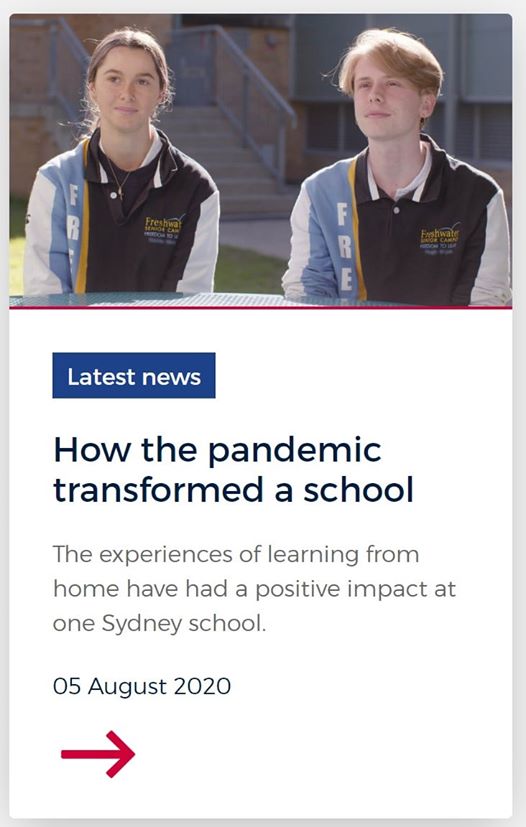 The experiences of learning from home have had a positive impact at one Sydney school.
The experiences of learning from home have had a positive impact at one Sydney school.
The learning from home experience has transformed education at Northern Beaches Secondary College Freshwater Senior Campus and moved the school forward in its embrace of technology by five to 10 years.
That is the view of principal Frank Pikardt and mathematics head teacher Simon Boon who oversaw the move from classrooms to zoom rooms.
Mr Pikardt said with a student cohort of Year 11 and 12, it was extremely important when the pandemic forced school closures that students felt confident their learning would not be disrupted.
He said the mathematics faculty at the school had already been trialling greater use of technology in the classroom and the pandemic accelerated a planned roll-out.
“It’s been such an interesting process for many of the teachers,” he said. “In terms of using technology in the classroom I think it’s accelerated us five to 10 years.”
Mr Boon said ahead of the pandemic he had already been working with ‘champion teachers’ to trial a range of technologies for mathematics classes.
“Our plans were to move toward this model [but] the COVID-19 experience sped up our transition and transformed our teachers’ classrooms because there was a need to do it at pace.”
He said many teachers needed support to adapt and learn new skills when the shutdown happened.
Mathematics teacher Anthony Thompson admitted he was one of those “old-style teachers” that used pen, paper, and a whiteboard.
“When we were told we were going remote, steepest learning curve I’ve ever faced,” he said.
Mr Thompson said once students returned to school he found the technology he had embraced for learning from home was still relevant.
He said he now recorded all his classes and students’ questions and had them available for those who might miss a class or wanted to revise.
“If I have kids who are away due to illness or other appointments, they can now watch a video and they are there for the whole class as if they were there.”
Mr Boon said better engagement in class was one of the main benefits of continuing to use the online technologies.
“[The online technology] had a transformative effect on our faculty and our whole school.” Mr Boon said.
He said the change in teaching practice was evident across the school.
“Teachers are communicating online, reducing the amount of time they spend preparing materials, and are collaborating and sharing materials,” he said.
“Because resources are prepared prior to class many students are looking forward to what they are learning and pre-learning.
“Students are connecting with each other out of class using those platforms. They can review the work and also because they are now digitising notes, students have less writing demands so can engage more in the actual lesson.”
Freshwater Campus HSC student Hugh Bryan said the use of online recordings was a huge help in his studies.
“For maths especially now everything’s just online if you need notes for something,” he said.
“A lot of my other classes have that as well … that’s really useful to have everything online so I can just get it when I need it.”
New Multimedia Site Gives Students A Voice In Education
Friday August 7, 2020
A multimedia hub aimed at giving NSW students a platform where they can share their views and creativity with the wider community was launched today.
Research shows authentic participation by students in their education can have a positive impact on their wellbeing and learning.
The ‘Student Voices’ hub on the NSW Department of Education website features content written and performed “by students, for students” including news, opinions, videos, music, podcasts, and creative works.
The initiative breaks new ground in Australian education by providing students with a platform to communicate with each other; and a way to influence the future of their education.
Talking about the innovation in the media today, Minister for Education and Early Childhood Learning Sarah Mitchell said student perspectives and experiences shaped schools.
"[The student voices hub] will also provide students with opportunities to refine their writing and content creation skills, along with pitching their stories and ideas," she said.
The site is backed by research, co-funded by the NSW Department of Education, that shows authentic participation by students in their education has significant positive impacts on student wellbeing and learning.
The Student Voices hub will also provide students with real-world experience in media with students having the opportunity to work with experienced journalists and editors to refine their ideas and articles, giving them a real-world insight into publishing.
As part of the student voices channel development a network of student journalist teams across NSW will be established, who will be mentored to develop and write news articles about their communities and schools.
Content on the launch site includes articles about student initiatives such as two brothers who raise awareness of racism by wearing one white and one black sock every day; a short film by a team at Punchbowl Boys High School on responsible e-gaming; student reflections on what the 250th anniversary of the Endeavour landing means to them; and a podcast by Macksville HSC students about completing Year 12 in the age of COVID-19.
The site will also host monthly polls based on questions submitted by students across the state.
Visit the Student Voices hub for more articles.
At: https://education.nsw.gov.au/student-wellbeing/student-voices
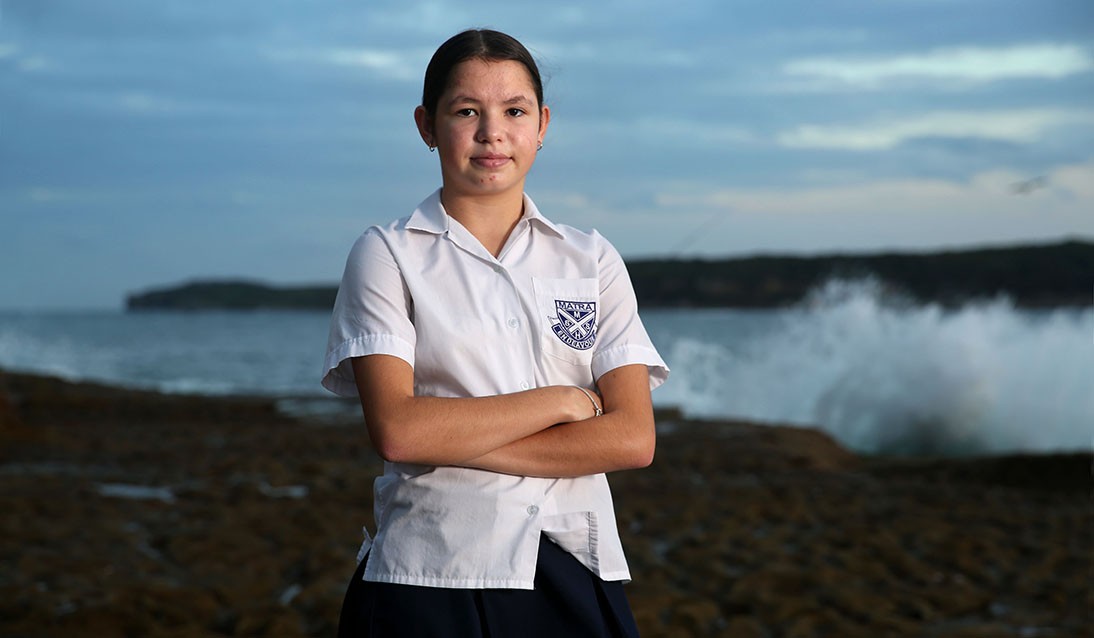
Budding Young Musos Take Out Awards
Monday August 3rd, 2020
Talented local duet Natalie Theodore and Julia Manias, known as Nat & Jules, have been voted winners of Northern Beaches Council’s 2020 Northern Composure Unplugged competition.
With the ten finalists’ performances professionally recorded and posted on the KALOF YouTube channel, the up-and-coming musicians received 1415 votes and over 6000 views.
Finalists were also assessed by a panel of music industry professionals, including Oli & Louis of popular band Lime Cordiale, former Hi-5 member Kellie Crawford, and one of Council’s Youth Advisory Group members.
Northern Beaches Council Mayor, Michael Regan, said all 34 entries in this year’s competition were to be praised for their exceptional talent and high level of professionalism.
“We can be very proud of our youth on the Northern Beaches, particularly gifted performing artists such as we’ve seen in this year’s comp,” Mayor Regan said.
“I would also like to thank everyone who watched their online performances and took time to vote.”
Vocal and guitar duo Nat and Jules take home winnings of $500 cash, a $600 product voucher from Mona Vale Music, an Ocean Alley merchandise pack as well as a marketing and publicity package from Perfect Pitch.
The remaining placegetters and prizes are:
- 2nd – Sophie O’Neill, instrumentalist, $250 cash and Mona Vale Music voucher;
- 3rd – Jocelyn Fletcher, instrumentalist & voice, $100 cash and Mona Vale Music voucher;
- People’s Choice Award – Chloe Tyrrell, instrumentalist & voice, cash Mona Vale Music voucher and Ocean Alley merchandise pack;
- Encouragement Award – Dhara Cullen, harpist, KALOF merchandise pack.
All finalists received a copy of their professionally-recorded performance to help them secure future performance opportunities and a gift pack.
Mona Vale Photography Competition
NASA Astronauts Safely Splash Down After First Commercial Crew Flight To Space Station
August 2nd, 2020: NASA
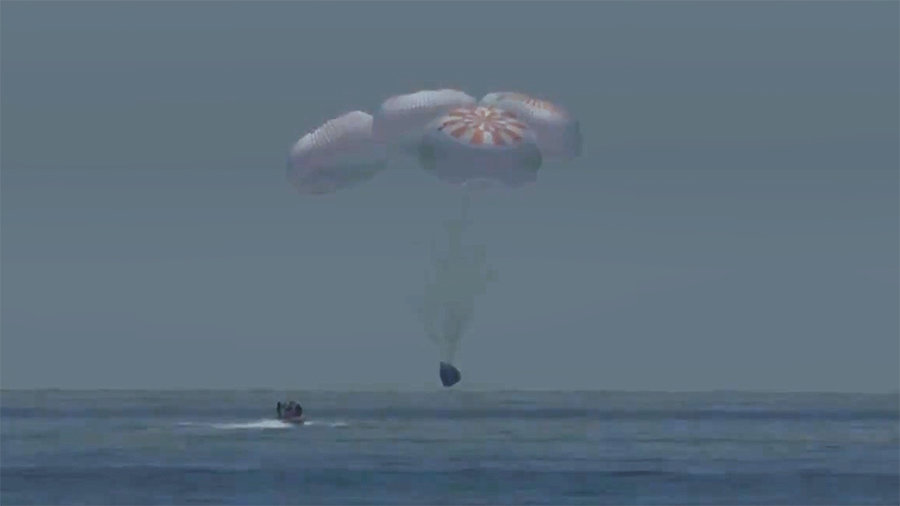
A SpaceX fast boat races toward the SpaceX Crew Dragon spacecraft moments before it splashed down in the Gulf of Mexico with NASA astronauts Bob Behnken and Doug Hurley aboard. Credit: NASA TV
Two NASA astronauts splashed down safely in the Gulf of Mexico Sunday for the first time in a commercially built and operated American crew spacecraft, returning from the International Space Station to complete a test flight that marks a new era in human spaceflight.
SpaceX's Crew Dragon, carrying Robert Behnken and Douglas Hurley, splashed down under parachutes in the Gulf of Mexico off the coast of Pensacola, Florida at 2:48 p.m. EDT Sunday and was successfully recovered by SpaceX. After returning to shore, the astronauts immediately will fly back to Houston.
"Welcome home, Bob and Doug! Congratulations to the NASA and SpaceX teams for the incredible work to make this test flight possible," said NASA Administrator Jim Bridenstine. "It's a testament to what we can accomplish when we work together to do something once thought impossible. Partners are key to how we go farther than ever before and take the next steps on daring missions to the Moon and Mars."
Behnken and Hurley's return was the first splashdown for American astronauts since Thomas Stafford, Vance Brand, and Donald "Deke" Slayton landed in the Pacific Ocean off the coast of Hawaii on July 24, 1975, at the end of the Apollo-Soyuz Test Project.
NASA's SpaceX Demo-2 test flight launched May 30 from the Kennedy Space Center in Florida. After reaching orbit, Behnken and Hurley named their Crew Dragon spacecraft "Endeavour" as a tribute to the first space shuttle each astronaut had flown aboard.
Nearly 19 hours later, Crew Dragon docked to the forward port of the International Space Station's Harmony module May 31.
"On behalf of all SpaceX employees, thank you to NASA for the opportunity to return human spaceflight to the United States by flying NASA astronauts Bob Behnken and Doug Hurley," said SpaceX President and Chief Operating Officer Gwynne Shotwell. "Congratulations to the entire SpaceX and NASA team on such an extraordinary mission. We could not be more proud to see Bob and Doug safely back home -- we all appreciate their dedication to this mission and helping us start the journey towards carrying people regularly to low Earth orbit and on to the Moon and Mars. And I really hope they enjoyed the ride!"
Behnken and Hurley participated in a number of scientific experiments, spacewalks and public engagement events during their 62 days aboard station. Overall, the astronaut duo spent 64 days in orbit, completed 1,024 orbits around Earth and traveled 27,147,284 statute miles.
The astronauts contributed more than 100 hours of time to supporting the orbiting laboratory's investigations. Hurley conducted the Droplet Formation Study inside of the Microgravity Science Glovebox (MSG), which evaluates water droplet formation and water flow. Hurley also conducted the Capillary Structures investigation, which studies the use of different structures and containers to manage fluids and gases.
Hurley and Behnken worked on numerous sample switch outs for the Electrolysis Measurement (EM) experiment, which looks at bubbles created using electrolysis and has implications for numerous electrochemical reactions and devices. Both crew members also contributed images to the Crew Earth Observations (CEO) study. CEO images help record how our planet is changing over time, from human-caused changes -- such as urban growth and reservoir construction -- to natural dynamic events, including hurricanes, floods, and volcanic eruptions.
Behnken conducted four spacewalks while on board the space station with Expedition 63 Commander and NASA colleague Chris Cassidy. The duo upgraded two power channels on the far starboard side of the station's truss with new lithium-ion batteries. They also routed power and Ethernet cables, removed H-fixtures that were used for ground processing of the solar arrays prior to their launch, installed a protective storage unit for robotic operations, and removed shields and coverings in preparation for the arrival later this year of the Nanoracks commercial airlock on a SpaceX cargo delivery mission.
Behnken now is tied for most spacewalks by an American astronaut with Michael Lopez-Alegria, Peggy Whitson, and Chris Cassidy, each of whom has completed 10 spacewalks. Behnken now has spent a total of 61 hours and 10 minutes spacewalking, which makes him the U.S. astronaut with the third most total time spacewalking, behind Lopez-Alegria and Andrew Feustel, and the fourth most overall.

NASA astronauts Robert Behnken, left, and Douglas Hurley are seen inside the SpaceX Crew Dragon Endeavour spacecraft onboard the SpaceX GO Navigator recovery ship shortly after having landed in the Gulf of Mexico off the coast of Pensacola, Florida, Sunday, Aug. 2, 2020. The Demo-2 test flight for NASA's Commercial Crew Program was the first to deliver astronauts to the International Space Station and return them safely to Earth onboard a commercially built and operated spacecraft. Behnken and Hurley returned after spending 64 days in space. Credits: NASA/Bill Ingalls
The Demo-2 test flight is part of NASA's Commercial Crew Program, which has worked with the U.S. aerospace industry to launch astronauts on American rockets and spacecraft from American soil to the space station for the first time since 2011. This is SpaceX's final test flight and is providing data on the performance of the Falcon 9 rocket, Crew Dragon spacecraft and ground systems, as well as in-orbit, docking, splashdown, and recovery operations.
Crew Dragon Endeavour will return back to SpaceX's Dragon Lair in Florida for inspection and processing. Teams will examine the spacecraft's data and performance from throughout the test flight. The completion of Demo-2 and the review of the mission and spacecraft pave the way for NASA to certify SpaceX's crew transportation system for regular flights carrying astronauts to and from the space station. SpaceX is readying the hardware for the first rotational mission, called Crew-1, later this year. This mission would occur after NASA certification, which is expected to take about six weeks.
The goal of NASA's Commercial Crew Program is safe, reliable and cost-effective transportation to and from the International Space Station. This could allow for additional research time and increase the opportunity for discovery aboard humanity's testbed for exploration, including helping us prepare for human exploration of the Moon and Mars.
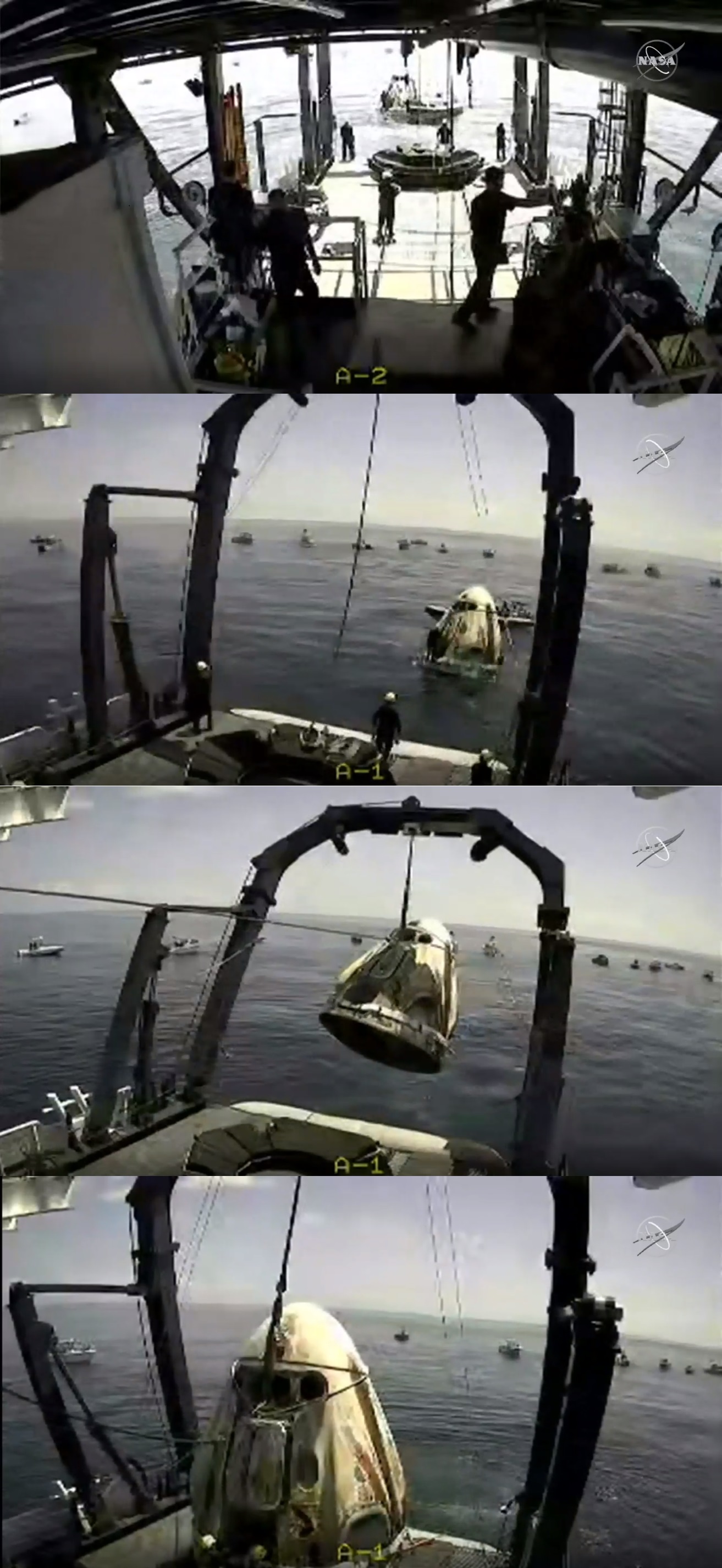
SpaceX’s Crew Dragon, carrying NASA astronauts Robert Behnken and Douglas Hurley, splashes down in the Gulf of Mexico off the coast of Pensacola, Florida at 2:48 p.m. EDT Aug. 2, 2020, where the spacecraft is recovered by SpaceX and brought aboard the recovery ship 'Go Navigator.' Credits: NASA Television
UNSW Partners With Women In AI To Launch Inter-Varsity Tech Series
August 5, 2020 by Dawn Lo, UNSW
Female students need to be tech agile because women are twice as vulnerable as men to losing their jobs to automation, says a UNSW tech expert.
In today’s economic climate, many companies are embracing technology to offset the impact of global uncertainties such as COVID-19. Big data is driving business growth in many instances, while 5G technology, cloud technology and digital transformation are expected to have significant effects in the next 12 to 18 months.
Institute for Public Policy research states that women are twice as vulnerable as men to losing their jobs to automation. It is a reality that prompted Dr Natalie Oh, Senior Lecturer at UNSW Business School, to launch the inter-varsity tech literacy program for female students.
“Universities need to help women better adapt to the changing requirements of the job market by providing them with the necessary knowledge, skills and opportunities. Through the inter-varsity tech literacy series, our aim is to deliberately target female students in business to reduce gender bias,” says Dr Oh.
“This program aims to empower female youths with skills in technology that translate to all fields of business, so that they are better prepared to initiate their careers within an industry that continuously experiences disruptive innovation.”
Dr Oh partnered with Angela Kim, the Australian ambassador for Women in AI to plan the program and help with the selection process. Four universities across NSW – UNSW, Macquarie University, University of Sydney and University of Technology Sydney – are taking part in the program, with the view of expanding interstate next year.
The program is structured into four virtual masterclasses and aims to help women defy gender inequality in the workforce by addressing the United Nation’s Sustainable Development Goals (SDG):
- Quality Education (SDG 4)
- Gender Equality (SDG 5)
- Reduce Inequality (SDG 10)
- Partnerships for the goals (SDG 17)
Tech giants Salesforce, Microsoft, DXC Technology, Yellowfin and Gradient Institute are all key participants in the program aiming to provide students with practical tech knowledge such as tools for data visualisation, blockchain and artificial intelligence (AI) products.
“We aim to address this problem through technology literacy programs so that young women are educated across a spectrum of technologies without having to necessarily pursue a degree in information technology. The goal of this program is to make business female students more tech agile,” Dr Oh says.
Why should women be more involved in the tech industry?
The aim of Women in AI is to provide empowerment to females looking to work in tech, with a clear focus on diversity and inclusion.
“One of the biggest risks when using AI is the unconscious bias being built into machine learning algorithms. As AI still needs human intervention and the majority of people working in AI are men, the process will naturally create algorithms from the male mindset. It is therefore essential to be aware of such biases and ethical components from the start of the design process and one way of achieving this is by including female input in machine learning,” Ms Kim says.
Ethics is also important when assessing the integrity of AI.
“You have to assess and review if you are compliant with the product and check if it is diverse and inclusive. Satisfying such requirements will soon become mandatory in Australia and other countries for tech products. Tech organisations are cognisant of this and have been proactively encouraging more females to build a career in tech.”
Has the gender gap in tech decreased?
The gender gap in the tech industry has not been bridged. The number of women interested in working in the industry has actually decreased, notes Ms Kim.
“As of December 2019, only 18 per cent of machine learning engineers who are specialising in AI production service creation were female,” she says.
The gender gap is due to misconceptions about the skills needed to work in AI.
“People think you have to be a hardcore data person or be a language programmer. What they don’t realise is that nowadays, nearly everything is automated. So, a lot less coding (or sometimes no coding) is needed. Also, by participating in workshops such as the inter-varsity tech literary series, this will help to break preconceived notions that females have about a career in tech.”
Ms Kim also says that many women looking to start a family have also chosen not to advance their career in tech due to technology-based roles that often come with tight implementation, deployment schedules and a somewhat inflexible work arrangement.
“The number of women in pure tech roles has consistently decreased industry-wide due to the lack of flexible working arrangement such as practical job-sharing roles from corporates and tech companies,” she says.
“Microsoft is a great example of a tech company that recently proposed a job-sharing model to be more inclusive. Through this model, two females can share one job and work part-time to balance other priorities they may have.”
Companies also need to lead by example and adapt a top-down approach when demonstrating the importance of flexibility at work, she says. An example is how Peter Harmer, CEO of IAG, often works from home on Fridays to encourage females to have a more flexible work arrangement.
“With greater awareness about AI bias and ethics, people are starting to have a more holistic view of what the problem is. I think the future is positive, because more people are beginning to think that a career in technology is not only for males,” Ms Kim says.
What do tech employers look for when recruiting?
What’s important is understanding the logic behind the technology being used and the ability to be tech agile, says Dr Oh.
“Our aim is not for females to be proficient in just one application. We want them to be exposed to as many technologies as possible so that they can be confident that whenever they pick up new technologies that they can do this,” Dr Oh says.
Rather than a particular skill set, Ms Kim says it’s more about being tech literate and having the agility to learn and master new technology suites.
“Curiosity for technology is very important for people to succeed in the tech industry. You also need to have a very open mindset and be ready to continuously learn and adapt to new changes.
“You need to be willing to put in your hours to acquire a new skill as well. Have grit and be resilient. The more you're confident, the more you become fluent in technology.”
Participants in the program have noted the benefits of the workshops and how it’s changed their views of a career in tech.
“The inter-varsity tech literacy series has offered an invaluable opportunity to learn about some of the most innovative technologies provided by market-leading tech companies. The workshops offer a great blend of practical learning and interactive Q&As. Although I did not have a strong tech background, every workshop has empowered me to explore different areas within the tech field and learn how to apply my interests in technology and business,” says Zoe Ong, Bachelor of Commerce/Information Systems student at UNSW Business School.
The program will conclude with The Grand Challenge on 29 October 2020 where teams will compete in a case challenge that focuses on the blend between business and technology. The winning team will have the opportunity to intern at one of the partnering tech organisations. Women in AI is also sponsoring the winning individual to travel to Paris and visit the Women in AI headquarters next year.
5 tips on writing better university assignments

University life comes with its share of challenges. One of these is writing longer assignments that require higher information, communication and critical thinking skills than what you might have been used to in high school. Here are five tips to help you get ahead.
1. Use All Available Sources Of Information
Beyond instructions and deadlines, lecturers make available an increasing number of resources. But students often overlook these.
For example, to understand how your assignment will be graded, you can examine the rubric. This is a chart indicating what you need to do to obtain a high distinction, a credit or a pass, as well as the course objectives – also known as “learning outcomes”.
Other resources include lecture recordings, reading lists, sample assignments and discussion boards. All this information is usually put together in an online platform called a learning management system (LMS). Examples include Blackboard, Moodle, Canvas and iLearn. Research shows students who use their LMS more frequently tend to obtain higher final grades.
If after scrolling through your LMS you still have questions about your assignment, you can check your lecturer’s consultation hours.
2. Take Referencing Seriously
Plagiarism – using somebody else’s words or ideas without attribution – is a serious offence at university. It is a form of cheating.

In many cases, though, students are unaware they have cheated. They are simply not familiar with referencing styles – such as APA, Harvard, Vancouver, Chicago, etc – or lack the skills to put the information from their sources into their own words.
To avoid making this mistake, you may approach your university’s library, which is likely to offer face-to-face workshops or online resources on referencing. Academic support units may also help with paraphrasing.
You can also use referencing management software, such as EndNote or Mendeley. You can then store your sources, retrieve citations and create reference lists with only a few clicks. For undergraduate students, Zotero has been recommended as it seems to be more user-friendly.
Using this kind of software will certainly save you time searching for and formatting references. However, you still need to become familiar with the citation style in your discipline and revise the formatting accordingly.
3. Plan Before You Write
If you were to build a house, you wouldn’t start by laying bricks at random. You’d start with a blueprint. Likewise, writing an academic paper requires careful planning: you need to decide the number of sections, their organisation, and the information and sources you will include in each.
Research shows students who prepare detailed outlines produce higher-quality texts. Planning will not only help you get better grades, but will also reduce the time you spend staring blankly at the screen thinking about what to write next.

During the planning stage, using programs like OneNote from Microsoft Office or Outline for Mac can make the task easier as they allow you to organise information in tabs. These bits of information can be easily rearranged for later drafting. Navigating through the tabs is also easier than scrolling through a long Word file.
4. Choose The Right Words
Which of these sentences is more appropriate for an assignment?
a. “This paper talks about why the planet is getting hotter”, or b. “This paper examines the causes of climate change”.
The written language used at university is more formal and technical than the language you normally use in social media or while chatting with your friends. Academic words tend to be longer and their meaning is also more precise. “Climate change” implies more than just the planet “getting hotter”.
To find the right words, you can use SkELL, which shows you the words that appear more frequently, with your search entry categorised grammatically. For example, if you enter “paper”, it will tell you it is often the subject of verbs such as “present”, “describe”, “examine” and “discuss”.
Another option is the Writefull app, which does a similar job without having to use an online browser.
5. Edit And Proofread
If you’re typing the last paragraph of the assignment ten minutes before the deadline, you will be missing a very important step in the writing process: editing and proofreading your text. A 2018 study found a group of university students did significantly better in a test after incorporating the process of planning, drafting and editing in their writing.

You probably already know to check the spelling of a word if it appears underlined in red. You may even use a grammar checker such as Grammarly. However, no software to date can detect every error and it is not uncommon to be given inaccurate suggestions.
So, in addition to your choice of proofreader, you need to improve and expand your grammar knowledge. Check with the academic support services at your university if they offer any relevant courses.
Written communication is a skill that requires effort and dedication. That’s why universities are investing in support services – face-to-face workshops, individual consultations, and online courses – to help students in this process. You can also take advantage of a wide range of web-based resources such as spell checkers, vocabulary tools and referencing software – many of them free.
Improving your written communication will help you succeed at university and beyond.![]()
Alexandra Garcia, Lecturer in Student Learning and Communication Development, University of Sydney
This article is republished from The Conversation under a Creative Commons license. Read the original article.
5 ways to get mental health help without having to talk on the phone

Access to mental health support has never been more important, as Melburnians are hit with a stage 4 lockdown and much of the rest of Australia braces for a potential second wave of COVID-19.
This year, many mental health professionals have moved to providing telehealth services via phone and video calls.
But what options are available for those who don’t like talking on the phone, or who find it difficult to find a quiet space to have a private conversation?
Fortunately, there are several ways to get help without having to speak a word.
Read more: State of disaster called as Melbourne moves to nightly curfew and stage 4 restrictions
1. Talk With A Therapist Via SMS Or Web Chat
You can access free web chat or text messaging services that allow you to talk with a therapist via messaging.
Lifeline launched an online chat service in 2011, and in 2018 it set up an SMS text service that is available between 6pm and midnight (AEST). These services provide short-term support if you’re in a crisis, with research showing reduced distress and increased coping and connectedness among users of the service.
The Beyond Blue online chat service is another option, established in 2013 and available daily between 3pm and midnight. This is a general service that offers short-term counselling with a trained counsellor, but does not provide crisis support. A recent study found those who received help from Beyond Blue experienced lower levels of distress (although the study evaluated the services as a whole, rather than separating out those who received help over the phone versus via web chat).
Similar web chat services are available for children, teens and young adults via the Kids Helpline.

2. Online Clinics Or Programs
Online clinics provide a range of self-guided mental health treatment programs. This means you work your way through the program at your own pace, without input from a mental health professional. These programs tend to have a variety of modules that provide information about common mental health symptoms, and include some suggested strategies about how best to manage these symptoms.
MindSpot is Australia’s first free national online clinic that offers psychological assessment and treatment for people experiencing common mental health problems such as anxiety, stress and depression. After completing an online assessment, you are directed to the appropriate online program, and can connect with a MindSpot therapist if you wish.
Mindspot programs include up to five lessons that can be completed over about eight weeks. Each lesson takes a few hours, and the general structure is to read through the lesson information and then practise the skills in your daily life. Throughout the program there are also real-life examples of people who have managed to overcome their symptoms, and there is an option for a weekly check-in with a therapist (although that would be over the phone). There have been more than 100 research studies relating to MindSpot, showing these treatment programs are effective in helping to reduce common mental health issues.
This Way Up programs are a suite of short online courses that cover a range of mental health concerns. You can select the course you’d like to do, and then work through a series of lessons and activities. For example, if you are struggling with low mood and worry, there is a mixed depression and anxiety course that provides material to develop skills in managing these symptoms. There are also options for you to select the approach that most appeals to you, including mindfulness-based or cognitive behavioural therapy (CBT) approaches (CBT uses strategies to help change unhelpful thoughts and behaviours). These courses cost A$59 each and access is available for three months. If you already have a psychologist, they can supervise your progress through the program.
These programs have been evaluated in many randomised controlled trials, with findings consistently showing they can be as effective as face-to-face therapy.
3. Peer Support Forums
Online peer support forums provide a safe online space where you can anonymously share your personal experiences and questions, and get support from others on the forum who may have helpful advice and suggestions based on their own experiences. These forums are usually moderated by professionals or trained volunteers and are places to get support rather than counselling, mental health treatment or crisis management.
Some popular mental health forums include those moderated by SANE, BeyondBlue, and headspace (for people aged 12-25). While evidence suggests peer support forums don’t necessarily reduce anxiety or depression, they are not harmful and may help to normalise emotional experiences and help users feel connected to others.
4. Smartphone Apps
There are many mental health smartphone apps available to download.
Many of these apps have not been scientifically tested to verify their health claims, although some apps that are supported by evidence include the Headspace app and Smiling Mind, both of which have a mindfulness focus. Mindfulness uses meditation to develop awareness and acceptance to reduce the impact of negative thoughts and feelings. Evidence suggests mindfulness meditation programs have beneficial effects on mental health.

5. Chat Bots
A chat bot is a program designed to simulate conversation with you, often using artificial intelligence. What this means is that you type in your thoughts, feelings and questions and an AI bot will respond to you.
There are several chat bots designed to provide mental health support. The most widely used ones are Woebot and Wysa (for children and teens). Both use artificial intelligence to deliver information based on cognitive behavioural principles, which can help you change your patterns of thinking or behaviour.
They aren’t designed to replace other forms of mental health support, but rather to complement them. But there is emerging evidence that chat bots can benefit mental health.
Read more: As 'lockdown fatigue' sets in, the toll on mental health will require an urgent response
Research published in July showed three-quarters of Australians are reporting worse mental health since the pandemic began, with feelings of loneliness, stress and worry being most common.
At a time when face-to-face consultations are impossible for many Australians, and if telehealth is just not your style, there are a host of other options worth considering — and many of them are free.
This article is supported by the Judith Neilson Institute for Journalism and Ideas.![]()
Aliza Werner-Seidler, Senior Research Fellow in Mental Health & Clinical Psychologist, UNSW and Sophie H Li, Senior Clinical Research Manager and Conjoint Lecturer in Psychology, UNSW
This article is republished from The Conversation under a Creative Commons license. Read the original article.
Popular High Blood Pressure Drug Linked To Increased Skin Cancer Risk In Older Australians
New Molecule Reverses Alzheimer's-Like Memory Decline
dingoes Have Gotten Bigger Over The Last 80 Years And Pesticides Might Be To Blame
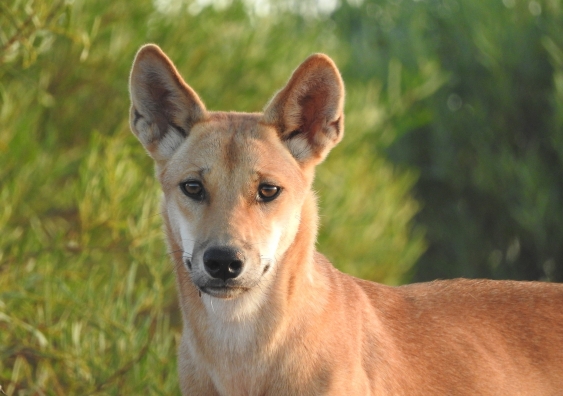
Tiny Plants Crucial For Sustaining Dwindling Water Supplies
COVID-19 Study In Australia Confirms Low Transmission In NSW Educational Settings
How Tumour Cells Evade The Immune Defense
Ancient Mountains Recorded In Antarctic Sandstones Reveal Potential Links To Global Events
Disclaimer: These articles are not intended to provide medical advice, diagnosis or treatment. Views expressed here do not necessarily reflect those of Pittwater Online News or its staff.